[ p. 260 ]
OPENING OF THE UPPER PALAEOLITHIC — THE GRIMALDI RACE — ARRIVAL OF THE CRO-MAGNON RACE AND OF THE AURIGNACLAN INDUSTRY — GEOGRAPHIC AND CLIMATIC CONDITIONS — MAMMALIAN LIFE — CHARACTERISTICS AND HABITS OF THE CROMAGNONS — DISTRIBUTION OF THE AURIGNACIAN INDUSTRY — THE BIRTH OF ART — ORIGIN AND DISTRIBUTION OF THE SOLUTREAN INDUSTRY — BRÜNN RAGE — SOLUTREAN INDUSTRY AND ART.
In the whole racial history of western Europe there has never occurred so profound a change as that involving the disappearance of the Neanderthal race and the appearance of the Crô-Magnon race. It was the replacement of a race lower than any existing human type by one which ranks high among the existing types in capacity and intelligence. The Crô-Magnons belonged to Homo sapiens, the same species of man as ourselves, and appear to have been the chief race of the Upper Palaeolithic Period up to the very close of Magdalenian times, after which they apparently underwent a decline.
Although there were one or more other races which influenced the industrial development of western Europe, the CrdMagnons were certainly dominant, as shown both by the abundance of their skeletal remains and by the wide distribution of their industry and art; the Upper Palaeolithic may almost be said to be the period of the Crô-Magnons as the Lower Palaeolithic is that of the Neanderthals and the Pre-Neanderthals. Their arrival toward the end of Mousterian times effected a social and industrial change and a race replacement of so profound a nature that it would certainly be legitimate to separate the Upper Palaeolithic from the Lower by a break equal to that which separates the former from the Neolithic.1
The arrival of the Crô-Magnons and the introduction of the [ p. 261 ] Aurignacian industry are the first events of the prehistory of Europe to which we can assign a date with any degree of confidence; they correspond geologically with the close of the fourth glaciation and the beginning of Postglacial time, the duration of which has been estimated by geologists from evidence of many different kinds, but which brings us, nevertheless, to substantially similar conclusions. It seems that 25,000 years is a conservative estimate for the duration of the Postglacial Period ; this is supported by the independent observations of Lyell, Taylor, Penck and Bruckner, and Goleman ; it is within the estimates made by Chamberlin and Salisbury, Fairchild, Sardeson, and Spencer ; it is somewhat larger than the estimates of Gilbert and Upham.[1] Thus, with considerable confidence we may record man of the modern type of Homo sapiens as entering western Europe between 25,000 and 30,000 years ago.
The Lower Palaeolithic industrial cycle, comprising the Chellean, Acheulean, and Mousterian, seems to have been similar in evolution both around the Mediterranean coasts and in the northern portions of Europe. From the fact that the Crô-Magnons arrived with the Aurignacian industry it would appear that they came through Phcenicia and along the southern coasts of the Mediterranean, through Tunis, into Spain ; also perhaps along the northern coasts of the Mediterranean through Italy. Their evolution had probably taken place somewhere on the continent of Asia, for their physical structure is entirely of Asiatic type, and not in the least, of African or Ethiopian type ; that is, they exhibit no negroid characters whatever. The reason that Breuil considers that the Aurignacian did not come in through central or eastern Europe is that there are no early Aurignacian stations in either region, whereas the Aurignacian is abundantly developed along the Mediterranean coasts, both of Europe and Africa. The passage of the Crô-Magnons along these coasts was, therefore, like the subsequent wave of the true Mediterranean race, dark-haired, long-headed, narrow-faced people, which followed this coast in early Neolithic [ p. 262 ] times, or, again, like the wave of the Arabian, or Moslem advance, which pressed forward along the northern coast of Africa and into southwestern Europe.
Some support of this theory of migration along the north coast of Africa is given by the presence of the skeletons of two members of an entirely distinct race, which are commonly known as the ‘negroids of Grimaldi’ because of their discovery in the Grottes de Grimaldi near Mentone, and because they alone among all the Upper Palaeolithic races thus far discovered in Europe display a number of resemblances to the African negroid race. Anatomically they are related neither to the Neanderthals nor to the Crô-Magnons. Their archaeologic age appears to be early Aurignacian because they are found immediately above the layer which marks the close of Mousterian time and the last climate favorable to the warm fauna of mammals.
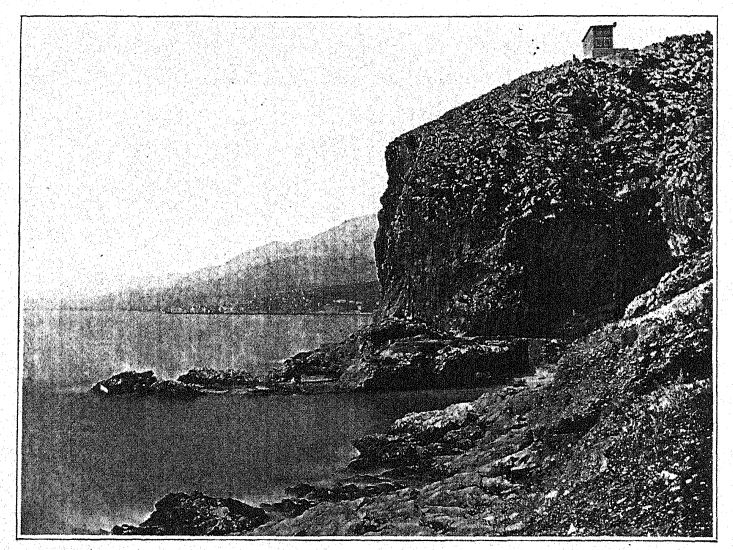
[ p. 263 ]
This sunny coast where modern France joins Italy has supplied some of the most valuable records of the racial and industrial transition from the Lower to the Upper Palaeolithic. Of the nine Grottes de Grimaldi three at least show evidences of occupation in closing Mousterian times, probably by men of the Neanderthal race, although no skeletal remains of Neanderthals have been found here. Four of the grottos, namely, the Grotte des Enfants, the Grotte de Cavillon, the Barma Grande, and the Baousso da Torre, have yielded altogether the skeletal remains of sixteen individuals, all associated with implements of Aurignacian culture and evidently representing a number of ceremonial burials. Fourteen of these skeletons are attributed by Verneau to the Crô-Magnon race; the other two are the ‘negroids of Grimaldi’ above referred to. This is, therefore, a prehistoric record of the greatest significance, which we shall now examine more in detail.
¶ Racial Succession along the Ancient Riviera
Where the southern spurs of the Alps descend into the Mediterranean and separate France from Italy we find a limestone promontory, known as the Baoussé Roussé, projecting in a long chff, beneath which the rocky shore descends abruptly into the sea. Opening toward the south, and at intervals along the base of this chff are the nine Grottes de Grimaldi. Doubtless the Neanderthals migrated along these shores at a time when the hippopotamus, the straight-tusked elephant (E. antiquus), and Merck’s rhinoceros (R. merckii) still abounded as the last representatives of the great African- Asiatic fauna. These hunters of Mousterian times entered the sea-swept floor of the great Grotte du Prince[2] (Fig. 131), wdth a ceiling height at that time perhaps of over 80 feet, carrying in their game to the fiire-hearths, and leaving Mousterian implements in the accumulating deposits. In the succeeding layers of this grotto the changing forms of animal life demonstrate the effect of the fourth glaciation [ p. 264 ] and the cooling of the climate toward the close of Mousterian times.
The smaller Grotte des Enfants (Fig. 132), which lies to the west of the Prince’s Grotto, was apparently occupied at a somewhat more recent period, because the lowest fire-hearths contain, together with the Mousterian implements, remains of Merck’s rhinoceros only — apparently the last survivor here, as well as in other parts of western Europe, of the warm African-Asiatic fauna. The hippopotamus and the straight-tusked elephant had either become extinct or had been driven farther south by the time the himters first occupied this grotto. In the overlying layers of this and several other grottos the firehearths contain remains of a rich forest fauna which includes the wild boar, stag, roe-deer, wild horse, wolf, and bear. The first signs of increasing Cold in the mountains to the north is the appearance of remains of the chamois and ibex driven from the Alpine heights. Then in still higher layers appears the reindeer, harbinger of the tundra climate.
¶ The Grimaldi Race
Verneau is inclined to regard the Grimaldi as a very ancient race, antedating the Crô-Magnon.2 He beheves that they belong to a new ethnic type which played an important r61e in Europe and enjoyed a wide geographic distribution. There does not, however, seem to be much support for this opinion, because, unlike some other races, no traces of the Grimaldis have been found elsewhere, and it would appear more probable that they were, as their skeletal characters indicate, true negroids which perhaps found their way from Africa but never became established as a race in western Europe.
The type consists of two skeletons found in the Grotte des Enfants by Verneau in 1906. One skeleton is that of a middleaged woman ; the other is that of a youth of sixteen or seventeen. Both are referred to the existing species of man, Homo sapiens. The layer which contained them is on a level two feet [ p. 265 ] [ p. 266 ] lower than any which contained Crô-Magnons, and immediately above the culture layer of Mousterian times.
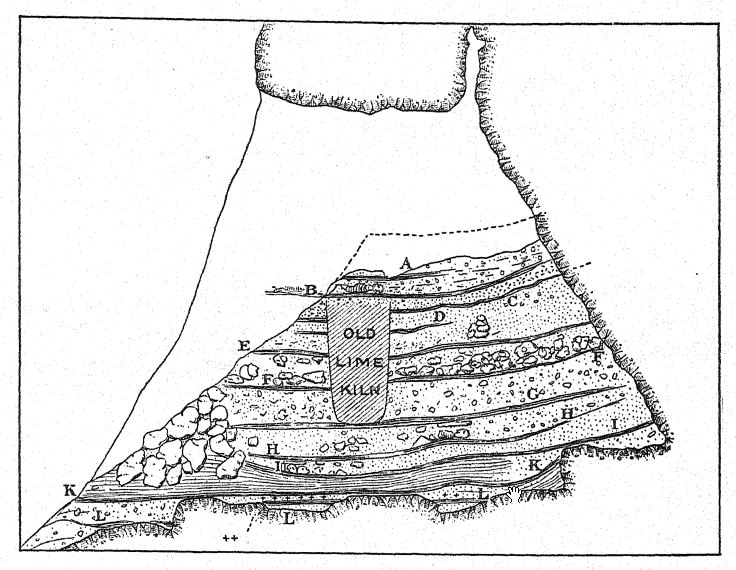
A. Burial of two infant skeletons. Remains of forest and alpine (Ibex) mammals.
B. Burial of the skeleton of a Crô-Magnon woman. Remains of forest and alpine mammals.
C. Fire-hearths containing forest mammals— the wild boar, also the reindeer.
D. Fire-hearths with flints of Aurignacian type. Remains of forest fauna—the marten.
E. Layer containing a cairn or artificial pile of stone. Remains of ibex, horse, wolf, cave-lion, and fox.
Intermediate layer. Remains of the wild ass, perhaps of the steppe type, and of the reindeer; also of the ibex, the wild horse, and forest fauna — the wild boar.
F. Large fragments fallen from the cave roof. No evidence of habitation.
G. Fire-hearths. Remains of the moose, roe-deer, fallow deer, stag, wild cattle, ibex, fox, leopard, and rabbit.
H. Burial of a very tall skeleton of the Crô-Magnon Race (see Fig. 144, p. 297). Fire I hearths containing remains of the forest fauna, also the alpine chamois and marmot, the cave-hyaena, and the leopard.
I. Burial of two skeletons of the Grimaldi Race (see Fig. 133, p. 267). Flints of Aurignacian type and remains of a forest fauna which includes the deer, also of the wild horse, the alpine ibex, and the hyiena.
K. Traces of charcoal and disturbed fire- hearths.
K-L. Remains of Merck's rhinoceros and of the hytena. Alpine (Thcx) and temperate forest fauna.
L. Traces of fire-hearths with Mousterian implements, chiefly of quartzite, probably left by members of the Neanderthal Race on the ancient floor of the grotto, following the recession of the sea. Evidence of previous occupation by hyaenas.
The Grimaldi characters present a wide contrast to those of the Crô-Magnon. The two known skeletons, of a woman and a youth, are of inferior stature, not exceeding 5 feet 3 inches :
Grimaldi female estimated at 1.57 m. 5 ft. 2 in.
“ youth “ “ 1.55 m. 5 ft. 1 in.
These measurements, however, are only slightly inferior to those of the Crô-Magnon woman and youth, which rise to 5 feet 5 inches. There are many negroid characters in the skull, in the structure of the hip-girdle, and in the proportions of the limbs ; there are also some characters in common with the anthropoid apes, namely, the long forearm, the curved thigh-bone, and the marked prognathism, or projection of the tooth row; the face is low and broad, and extremely prognathous; the nose is platyrhine, or broad and flat ; the jaw is heavy, with large teeth and without the chin prominence; the head form, like that of the Crô-Magnons, is dohchocephalic and somewhat disharmonic; that is, while the head is long, the face is short and relatively broad. Yet the cranial capacity is relatively high, being estimated at 1,580 c. cm. Unlike the Crô-Magnons, the Grimaldis have a relatively long forearm and a negroid type of pehds. The proportions of the leg are, however, somewhat similar to those of the leg of the Crô-Magnon, the thigh-bone being short and the shin-bone long, the index being 83.8 per cent. In addition to the long forearm, which approaches in form that of the living anthropoid apes, there is a curved femur, distinctly of anthropoid-ape character.
“In its body and tooth characters,” observes Verneau,3 “this negroid race in many respects shows a greater resemblance to the anthropoid apes than does the Neanderthal race.” He continues: “The fact remains that at a very remote period of the Pleistocene there existed in Europe, beside the Neanderthal race, a type of man that in many of his cephalic characters, in the structure of his pelvis, and in his limb proportions showed striking [ p. 267 ] analogies to the negro of to-day. In their remarkable proportions they exaggerate some of the peculiarities of the recent negroes , the teeth resemble those of the Australian types.
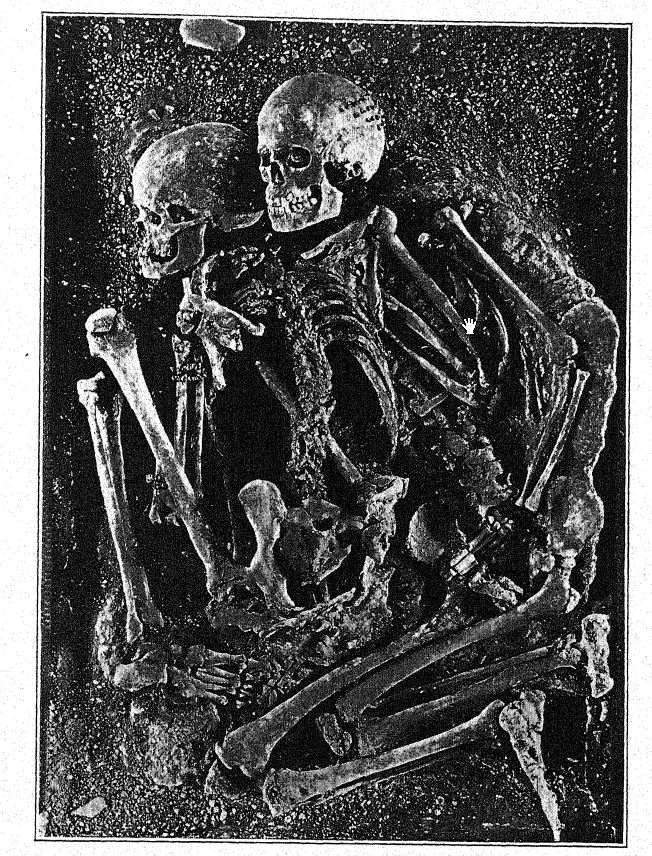
There is evidence of the establishment and spread of the Grimaldi race throughout western Europe, namely, in cases of partial reversion to this type among the skeletal remains of the Neolithic Age, the Bronze Age, and the early Iron Age in Brittany, [ p. 268 ] Switzerland, and northern Italy. Extreme prognathism is the characteristic that most frequently appears, and in some instances there is the broad nose, with the same osteological peculiarities that mark the Grimaldi type. In every instance these individuals show dolichocephaly, nearly always combined with a short, broad face. Until the discovery of the Grimaldi type we were at a loss to explain the existence of these individuals among a population from which they differed so radically.”
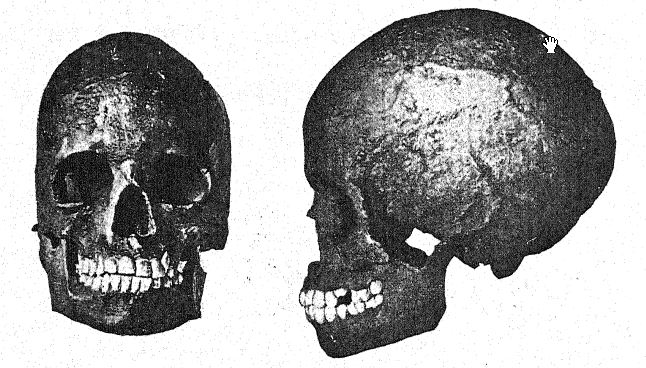
Against this opinion of Verneau we should weigh the entire absence of any trace of this Grimaldi race in any part of western Europe among all the burials and other human remains of Upper Palaeolithic age known at the present time. Setting aside any such records which are of doubtful authenticity or difficult to diagnose on account of their fragmentary nature, there remains a number of human fossils representing at least ninety individuals discovered at over fifteen widely distributed localities. None of these shows any features of the Grimaldi race.
In describing the Grimaldi skeletons, Keith4 agrees that they are of a mixed or negroid type ; the shallow, projecting incisor part of the upper jaw and the characters of the chin are features of recent negroid races ; so are the wide opening of the nose, the prominent cheek-bones, the flat and short face. Yet the bridge [ p. 269 ] of the nose is not flat as in negroes, but rather prominent as in Europeans, and the capacity of the skull in the woman (1,375 c. cm.) is ample. In the boy the teeth are large and of the negro type; he bears a striking resemblance to the woman, and his cranial capacity (1,580 c. cm.) indicates a distinctly modern brain ; the prominences of the forehead do not meet across the median line as in certain negroids and in the Neanderthals. Keith concludes that the Grimaldi people represent an intermediate type in the evolution of the typical white and black races.
¶ MAIN FEATURES OF THE ENTIRE UPPER PALAEOLITHIC HISTORY
Having now considered the opening of the Upper Palaeolithic, also the single appearance of the Grimaldi race of which no further trace is known, it is desirable to briefly review the entire Upper Palaeolithic history before we attempt to follow in detail its successive phases beginning with the appearance of the Aurignacian industry.
There is evidence of various kinds that the Crô-Magnons arrived in western Europe, bringing in their Aurignacian industry, while the Neanderthals were still in possession of the country and practising their Mousterian industry. Thus in the valley of the Somme, Commont beUeves he has recognized a level of flints, exhibiting the primitive Aurignacian 'retouch’ of Dordogne, but occurring beneath a late Mousterian level. xAdditional evidence of a contact between the industries of these two races is found at the stations of La Ferrassie, of Les Boufiia, and especially of the Abri Audit, where there is a distinct transition period, in which the characteristic types of the late Mousterian are found intermixed with a number of flints suggesting the early Aurignacian here it would appear that the development of the Aurignacian is partly a local evolution, and not an invasion of wholly new types of implements. Breuil6 suggests that these mixed layers may perhaps be explained by the supposition [ p. 270 ] that we have here degenerate or modified Mousterian tools, more or less influenced by contact with the Aurignacian industry of the Crô-Magnon race.
THE STONE IMPLEMENTS CHARACTERISTIC OF LOWER AND UPPER PALEOLITHIC TIMES
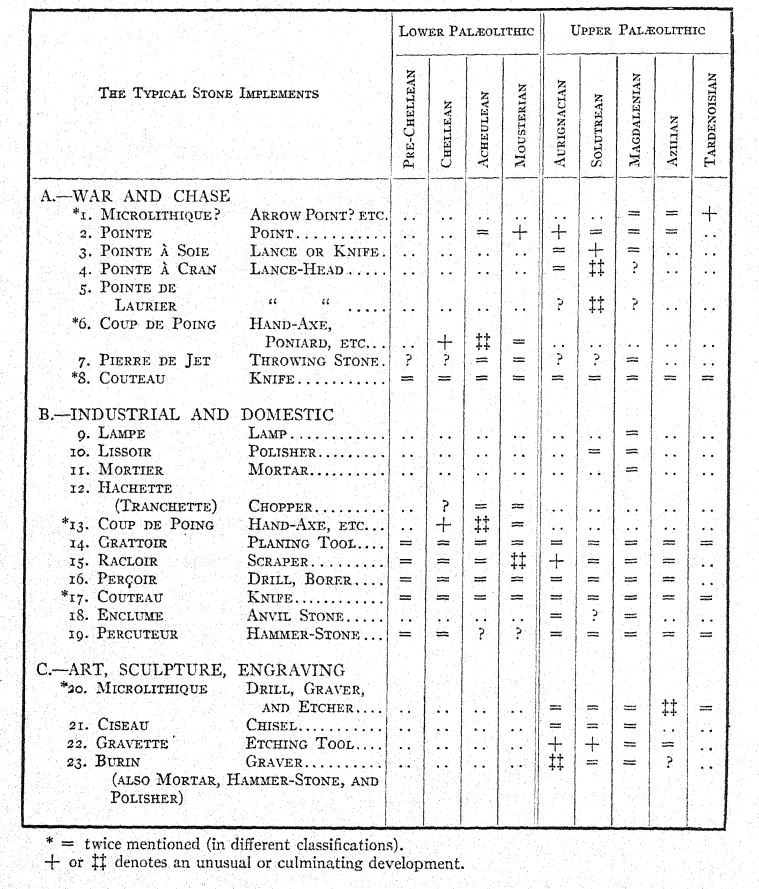
Again, the burial customs of the Neanderthals were in many respects followed by the Crô-Magnons ; they chose, in fact, the same kind of burial sites, namely, at the entrances of grottos [ p. 271 ] or in proximity to the shelters. Some degree of ceremony must have marked these burials, for with the remains were interred implements of industry and warfare together with offerings of food. Most of the Neanderthal burials where with the body extended; the two burials of the Grimaldi race were with the limbs in a flexed position and tightly boimd to the body, probably with skin garments or thongs. The Crô-Magnon burials are either with the body extended, as in the Grottes de Grimaldi, or with the limbs flexed, as in the Aurignacian burial of Laugerie Haute.
THE BONE IMPLEMENTS APPE.A.RING AT THE CLOSE OF THE LOWER PALEOLITHIC AND HIGHLY CHARACTERISTIC OF THE UPPER PALEOLITHIC
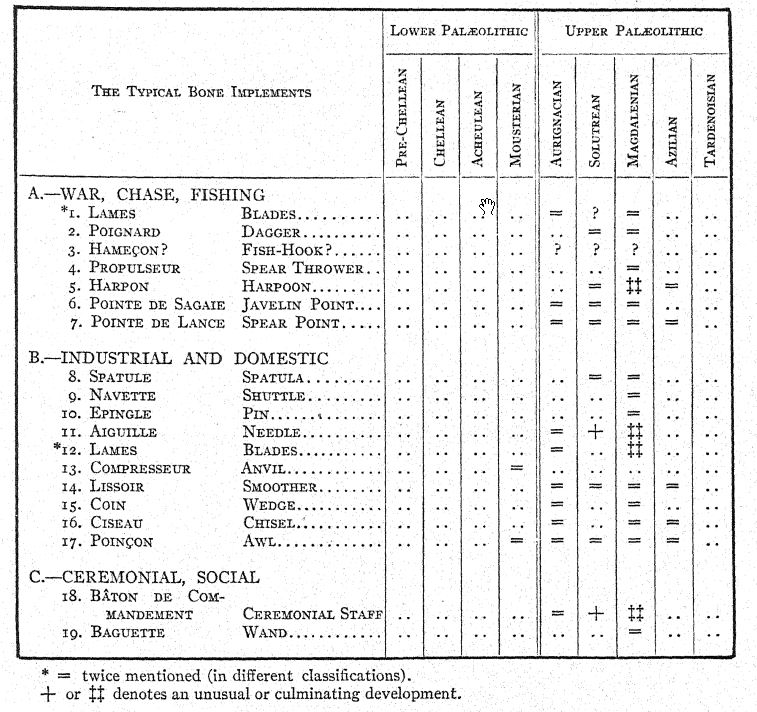
[ p. 272 ]
Whether the Neanderthals were exterminated entirely or whether they were driven out of the country is not known; the encounter was certainly between a very superior people, both physically and mentally, who possibly had the use of the bow and arrow, and a very inferior and somewhat degenerate people that had been already reduced physically and perhaps numerically by the severe climatic conditions of the fourth glaciation. The Neanderthals were dispossessed of all their dwelling-places and industrial stations by this new and vigorous race, for at no less than eighteen points the Aurignacian immediately succeeds upon the Mousterian industry and in a few instances Crô-Magnon burials occur very near the Neanderthal burial sites.
In the racial replacements of savage as well as of historic peoples the men are often killed and the wmmen spared and taken into families of the warriors, but no evidence has thus far been found that even the Neanderthal women were spared or allowed to remain in the country’, because in none of the burials of Aurignacian times is there any evidence of the crossing or admixture of the Crô-Magnons and the Neanderthals.
The chief source of the change which swept over western Europe lay in the brain power of the Crô-Magnons, as seen not only in the large size of the brain as a whole but principally in the almost modern forehead and forebrain. It was a race which had evolved in Asia and which was in no way connected by any ancestral links with the Neanderthals ; a race with a brain capable of ideas, of reasoning, of imagination, and more highly endowed nnth artistic sense and ability than any uncivilized race which has ever been discovered. No trace of artistic instinct whatever has been found among the Neanderthals; we have seen developing among them only a sense of symmetry and proportion in the fashioning of their implements. After prolonged study of the works of the Crô-Magnons one cannot avoid the conclusions that their capacity was nearly if not quite as high as our own ; that they were capable of advanced education; that they had a strongly developed aesthetic as well as a religious sense ; that their society was quite highly differentiated [ p. 273 ] [ p. 274 ] [ p. 275 ] along the lines of talent for work of different kinds. One derives this impression especially from the conditions surrounding the development of their art, which are still mysterious and an interpretation of which we shall attempt to give in the following chapter.
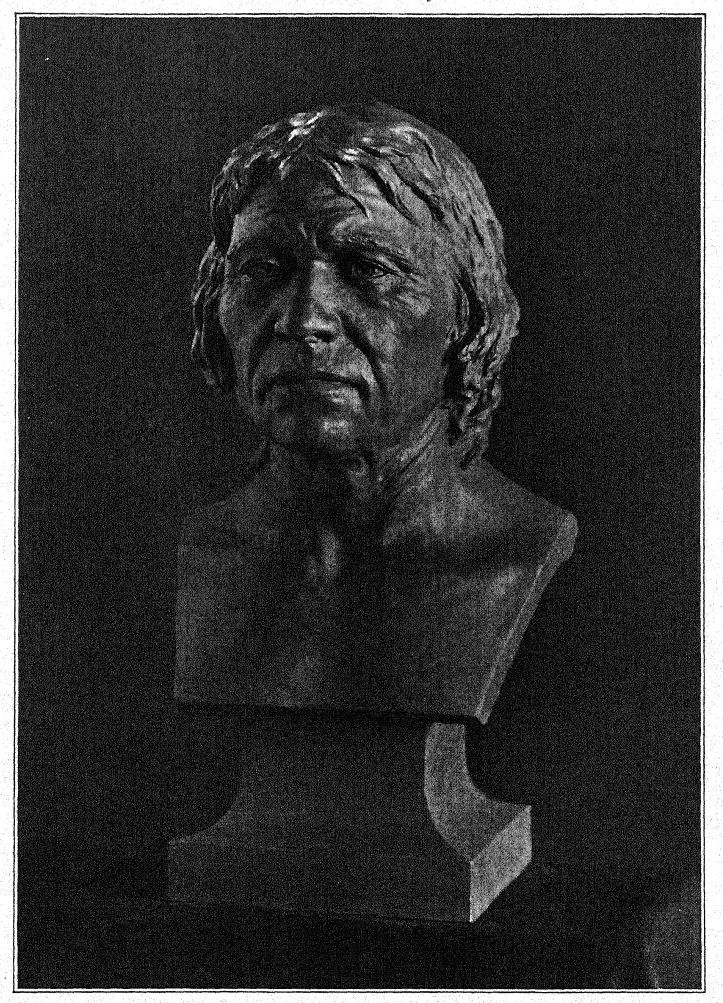
¶ Cultural, Racial, and Climatic Divisions
The Upper Palaeolithic covers the greater part of the ‘Reindeer Epoch’ as it was conceived by Lartet and Christy, who began their systematic study and exploration of the caves of Dordogne in 1863. They were soon joined by Massenat and the Marquis de Vibraye, while Dupont took up the work in Belgium and Piette made the artistic development, especially in the Pyrenees, his chosen field.
Lartet was the first to perceive that the culture of the grotto of Aurignac was quite distinct from that of the Lower Palaeolithic in northern France ; he also recognized in the shelter of Laugerie Haute, in Dordogne, that there was still another culture, which is now known as the Solutrean ; also that in the shelter of Laugerie Basse, in Dordogne, there was yet another industry, that which we now know as Magdalenian. M. de Mortillet was the first to recognize the superiority of the Solutrean industry in stone, which in this period reached its height, and its succession by the Magdalenian period, in which the industry in bone and horn reached a climax; but he failed to recognize the very important preceding position of the Aurignacian, and it was not until 1906 that the clear presentation by Breuil of the entire distinctness of the Aurignacian industry led to the adoption by the Archeological Congress at Geneva of three cultural diAusions of the Upper Paleolithic. In the meantime Piette had discovered that in the Mas d’Azil there was a distinct cultural phase, the Azilian, following the Magdalenian, and thus a fourfold division of the Upper Paleolithic (Breuil,7 Obermaier8) was established, as follows :
AZILIAN . — Industry of the surviving Crô-Magnon and other resident races, and of newly arrived brachycephalic and dolichocephalic races in [ p. 276 ] western Europe; decadent forms of flint and bone workmanship; entire absence of art. Daun stage of Postglacial retreat; Europe with a milder climate and forest and meadow fauna like that of early historic times.
MAGDALENIAN . — Closing stage of the industry and art of the Crô-Magnon race; bone implements highly developed; marked decline in the flint industry. Close of Postglacial Period; climate alternately cold and moist (corresponding with the Bühl and Gschnitz Postglacial advances of the ice in the Alpine region), or cold and arid; Europe covered with the tundra and steppe fauna; life chiefly in the shelters and grottos.
SOLUTREAX . — Culminating stage of flint industry; apparent invasion in eastern Europe of the Brünn (Brüx, Predmost, and [?] Galley Hill) race. The highly developed flint industry of the Solutrean types; art development of the Crô-Magnon race partly suspended. Dry, cold climate; life largely in the open.
AURIGNACIAN . — Appearance of the Crô-Magnon race in southwestern Europe, succeeding the Mousterian industry; art of engraving and drawing and sculpture of human and animal forms developing. Animal life the same as during the fourth glaciation; climate cold and increasingly dry; life chiefly in the grottos and shelters.
The successive phases of development of Upper Palaeolithic industry and art have been traced with extraordinary precision in Dordogne, in the Pyrenees, in northern Spain, and along the Danube and upper Rhine by a host of able workers — Cartailhac, Capitan, Peyrony, Bouyssonnie, Lalanne, and others. Breuil has made himself master especially of the Aurignacian and has succeeded Piette as the great historian of Upper Palaeolithic art. Obermaier’s chief service has been the comparison of the Upper Paleolithic of the Danubian region with that of Dordogne and northern Spain both in regard to the geologic age and the archeologic and racial succession. The labors of Schmidt along the upper Rhine and Danube have not only brought this region into definite prehistoric relation with the Dordogne and the Pyrenees but have given us by far the clearest evidence of the relation between the human and the industrial development and the succession of climatic phases in northern Europe. Finally, the explorations of Commont along the River Somme have proved that this region, too, was frequented throughout all Upper Paheolithic times, during which it exhibits an industrial development hardly less important than that of the Lower Palaeolithic.
[ p. 277 ]
There are two very distinct lines of thought among these arckeologists : the first is shown in the tendency to regard the industries as mainly autochthonous, or as following local lines of development ; the exponents of this theory dwell most strongly on the transitions between the Mousterian, the Aurignacian, and the Solutrean industries. For example, the chief object of Schuchhardt’s tour9 through the Palaeolithic stations of Dordogne was to observe the transitions from one period to another and the evidence afforded of successive changes of climate. This writer is impressed with the transitions; he notes that the typical curved knives of the Abri Audit furnish a transition from the Mousterian scrapers to the Aurignacian ‘points’ of La Gravette and La Font Robert; that the Solutrean takes up all the fine threads of the Aurignacian culture and spins them further into Magdalenian times. Thus we get an Aurignacian-Solutrean-Magdalenian industrial cycle which is comparable to the Chellean-Acheulean-Mousterian cycle.
Breuil, on the other hand, from the archaeologist’s standpoint— because he is not especially interested in the matter of racial development — is a strong exponent of the idea of successive invasions of cultures, either from the south or Mediterranean region or from the central region of Europe, which he calls the ‘Atlantic’; and he distinguishes sharply between these two great areas of Upper Palaeolithic evolution, namely, the southern and the central European, pointing out that it was only after the establishment of more genial climatic conditions, like those of modem times, that there was an added element of northern or Baltic invasion. Certainly the archaeologic testimony strongly supports this culture-invasion hypothesis and it appears to be strengthened in a measure by the study of the human types, although this study has not progressed beyond the stage of hypothesis. When the Upper Palaeolithic races have been studied with as close attention as those of the Lower Palaeolithic we may be able to establish positively the relation between these human types and the advance of certain cultures and industries.
[ p. 278 ]
¶ Distribution of Upper Palaeolithic Human Fossils
Our present view, as drawn from a consideration of the facts before us, is that western Europe in Upper Palaeolithic times was entered by four or five distinct races, all belonging to Homo sapiens, only three of which became established:.
5. The Furjooz (Ofnet, and [?] Grenelle) race, extremely broad-headed, entering central Europe possibly from central Asia, bringing an Aziiian culture, without art or developed Hint industry. (Alpine type.)
4. A dolichocephalic race with a narrow face, associated with the Furfooz race, either connected with the Brünn and Brüx, or an advance wave of one of the dolichocephalic Neolithic races. (Mediterranean type.)
3. The Brünn (Brüx, Predmost, and [?] Galley Hill) race, long-headed, with a narrow, short face, probably entering central Europe directly from Asia through Hungary and along the Danube; bringing a perfected Solutrean culture; inferior in brain development to the Crô-Magnons, in industrial contact with them but not displacing them.
2. The Crô-Magnon race, long-headed a very broad face, entering Europe in closing Mousterian or early Aurignacian times, probably from the south along the Mediterranean coast, and bringing in an Aurignacian flint industry and art spirit characteristic especially of Aurignacian and Magdalenian times ; greatly reduced in number in closing Magdalenian times, but leaving descendants in various colonies in western Europe.
1. The Grimaldi race, in the transition between the Mousterian and the Aurignacian; negroid or African in character; apparently never established as a race of any influence in western Europe.
The presence of these five races, and perhaps of a sixth if the ‘Aurignacian man’ of Klaatsch proves to be distinct from the Crô-Magnon, is firmly established by anatomy. It is most important constantly to keep before our minds certain great principles of racial evolution: (1) that the development of a racial type, whether long-headed or broad-headed, narrow-faced or broad-faced, of tall or of short stature, must necessarily be very slow; (2) that this development of the races which invaded western Europe took place for the most part to the eastward in the vast continent of Asia and eastern Europe ; (3) that, once established through a long process of isolation and separate evolution, these racial types are extremely stable and persistent; their head [ p. 279 ] form, their bodily characters, and. especially their psychic characters and tendencies are not readily modified or altered ; nor are they in any marked degree blended by crossing. Crosses do not produce merely blends; they chiefly produce a mosaic of distinct characters derived from one race or the other.
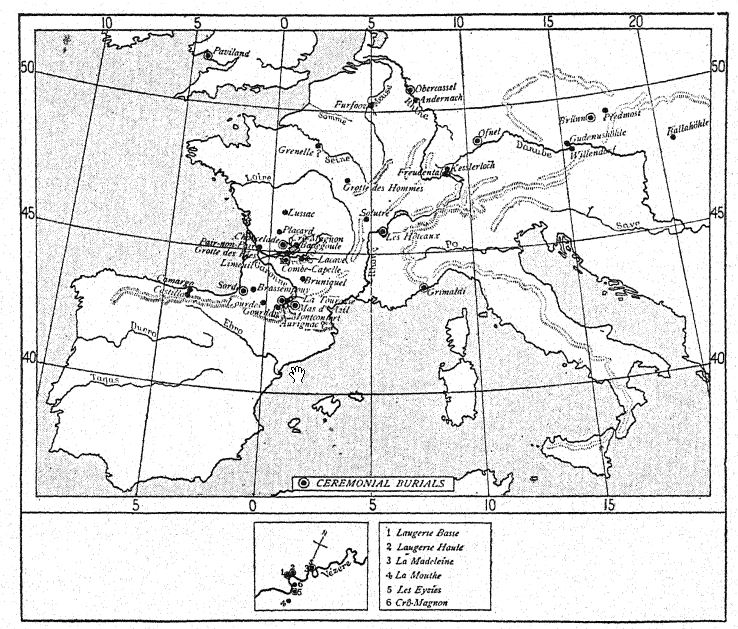
We must therefore imagine western Europe in Upper Palaeolithic times again as a terminal region ; a great peninsula toward which the human migrants from the east and from the south came to mingle and superpose their cultures. These races took the great migration routes which had been followed by other waves of animal life before them; they were pressed upon from behind by the increasing populations of the east; they were attracted to western Europe as a fresh and wonderful game country, where food in the forests, in the meadows, and in the streams abounded in unparalleled profusion. The Crô-Magnons especially [ p. 280 ] were a nomadic hunting people, perfectly fitted by their physical structure for the chase and developing an extraordinary appreciation of the beauty and majesty of the varied forms of animal life which existed in no other part of the world at the time. Betw’een the retreating Alpine and Scandinavian glaciers Europe was freelv open tow’ard the eastern plains of the Danube, extending to central and southern Asia ; on the north, however, along the Baltic, the climate was still too inclement for awwe of hmnan migration, and there is no trace of man along these northern shores until the close of the Upper Palaeolithic, nor of any residence of man in the Scandinavian peninsula until the great wave of Neolithic migration established itself in that region.

The climatic and cultural relations of Upper Palaeolithic times may be correlated[3] in descending order as follows :
[ p. 281 ]
6. The Daun or final Postglacial advance of the glaciers of the Alps, estimated at 7,000 B. C. Europe with its modern or prehistoric forest fauna, the lion lingering in the Pyrenees, the moose in Spain. AztlianTardenoisian, closing stage of the Upper Palaeolithic culture; western Europe peopled by the broad-headed race of Furfooz and Ofnet, also by a narrow-headed race. Baltic Migration, MAGLEMOSE culture.
5. The Gschnitz stage in the Alps or second Postglacial advance. Climate still cold and moist but gradually moderating. Decline of the Magdalenian. Period of the retreat of the tundra and steppe animals; mammoth, remdeer, and arctic rodents becoming more rare; Eurasia tic forest mammals becoming more abundant.
Close of steppe period. Crô-Magnon race still dominant in western Europe in the LATE MAGDALENIAN stage of culture.
4. Interval between the Bühl and Gschnitz Postglacial advances in the Alps. A rene’wed steppe and Toess’ period. Climate cold and dry. Mammoth and woolly rhinoceros, reindeer, full tundra and steppe fauna very abundant. Crô-Magnon race in the stage of MIDDLE MAGDALENIAN culture.
3. The Bühl stage of Postglacial advance in the Alps ; renewal of severe conditions of cold moist climate, and spread all over western Europe of the arctic banded and Obi lemmings of the Upper Rodent Layer. Bühl moraines in Lake Lucerne estimated as having been deposited between 16,000 and 24,000 years B. C. Crô-Magnon race dominant in the EARLY MAGDALENIAN stage of culture.
2. Period of the first Postglacial interval or Achen retreat of the glaciers in the Alpine region, A dry cold climate. Crô-Magnon and Brünn races ill the stage of SOLUTREAN culture.
1. Close of fourth glaciation, between 24,000 and 40,000 years B. C. Cold and moist but increasingly dry climate succeeding the fourth glaciation and deposition of Lower Rodent Layer, or first invasion of the arctic tundra rodents. Crô-Magnon and possibly Aurignacian race in the stage of AURIGNACIAN culture.
¶ BEGINNING OF THE UPPER PALAEOLITHIC
¶ The Aurignacian Industry
We now glance at western Europe as it was between 25,000 and 30,000 years ago, at the opening of the Upper Palaeolithic.
During Aurignacian times France was still broadly connected with Great Britain.11 The British Islands were not [ p. 282 ] only united with each other but with the continent, while the elevation of the Scandinavian peninsula converted the Baltic Sea into a great fresh-water lake, the old shores of which are readily traced. Geikie also maintains that the rise of land in Scotland after the fourth glaciation was accompanied by an amelioration of climate and the advent of more genial conditions ; a strong forest growth covered the lowlands, hence this is termed the Lower Forestian stage of the physiographic history of northern Britain; it corresponds to the temporary period of the retreat of the glaciers in the Alpine region, which Penck has named the Achenschwankung. The latter author is not inclined to connect any marked rise of temperature in the Alpine region with this interval of time ; to our knowledge no fossil plant beds have been preserved which would give us such indications, and the animal life, as we shall see, certainly affords only a very slight indication of a rise in temperature in the retreat of certain of the snow-loving tundra and northern steppe lemmings to the north; the greater number of tundra forms remained. The continental elevation of the northern coast-line of Europe would explain the advent of a dry continental climate and the renewal of high prevailing winds, at least during the warmer and drier summer seasons, for it is certain that atmospheric conditions such as produced the great dust-storms and deposition of ‘loess’ after the second and third glaciations prevailed again in western Europe after the fourth glaciation. This gave rise to deposits of what is known among geologists as the ‘newer loess,’ and we find these sheets of ‘newer loess’ spreading immediately above the Mousterian culture at a number of different points in western Europe.
When the Crô-Magnon race entered this part of Europe the climate was becoming more dry and stimulating ; the summers were warm or temperate, the winters very severe. Great icecaps still spread over the Scandinavian peninsula and also over the Alps, but the borders of the ice-fields no longer reached the plains; in a sense, the Glacial Epoch had not yet closed, for during the whole period of Postglacial time the glaciers of the [ p. 283 ] Alps, beginning in early Magdalenian times, developed three renewed advances, each somewhat less vigorous than the preceding one, with intervening stages of a drier climate.
The greater number of the Aurignacian stations, like those of Mousterian times, were under the shelters or within the entrances of the grottos and caverns ; all the stations in southwestern France are of this character. There was, however, a great open camp at Solutré, which was a most famous hunting station for the wild horse in Aurignacian times. In northern France there are several open stations, such as those of Montieres and St. Acheul, along the River Somme, and to the east, [ p. 284 ] along the middle Rhine, there are several open ‘loess’ stations, such as those of Achenheim, Volklinshofen, Rhens, and Metteriiich. It may very well be that these open stations were visited only during the mild summer season. The continued choice of sites which naturally afforded the greatest protection from the weather, in France, Britain, Belgium, and all along the Danube, as well as in the genial region of the Riviera, is a sure indication of a prevailing severe climate. It is hardly possible, however, that the closed or protected stations were the only residences of these people; they merely indicate the points where the flint industry was continuously carried on and also the vast foyers and gathering places; but there is little doubt from the evidence afforded by the signs on the walls of the caverns, known as ‘tectiforms,’ that huts and large shelters built of logs and covered with hides were grouped around most of these stations and scattered through the country at points favorable for hunting and fishing. These would be the only dwellingplaces possible in such vast open camps, for example, as Solutré.

¶ Climate and Life of Aurignacian Times
3. First Postglacial Retreat, Achenschwankimg in the Alpine region. Period of Solutrean industry. A cold dry climate, with dust-storms and wide-spread deposition of ‘loess’ in we.stern Europe. Flint workers seeking many open stations. Horses and wild asses numerous on the prairies; reindeer and wild cattle very abundant.
2. Recession of the Ice-Fields of the Fourth Glaciation. Period of Aurignacian industry. Climate cold and increasingly dry ; renewal of the duststorms and deposits of the ‘newer loess.’ Flint industry in the caverns, grottos, shelters, and a few open stations. Opening of the Upper Palaeolithic period. Arrival of the Crô-Magnon race.
1. Final Stage of Fourth Glaciation. Close of the Lower Palaeolithic Mousterian culture. Gradual extinction of the Neanderthal race.
The arrival of the Crô-Magnon race and the beginning of the Aurignacian industry took place during the period of retreat of the ice-fields of the fourth glaciation. As we pass from the levels of the early Aurignacian industry into those of the middle and upper Aurignacian, we find that the mammal life of Mousterian [ p. 285 ] times continued in its prime ail over western Europe, with the addition, one by one, of some new forms from the tundras, such as the musk-ox, and the successive arrival from the mountains and steppes of western Asia of such characteristic forms as the argali sheep and the wild ass, or kiang.
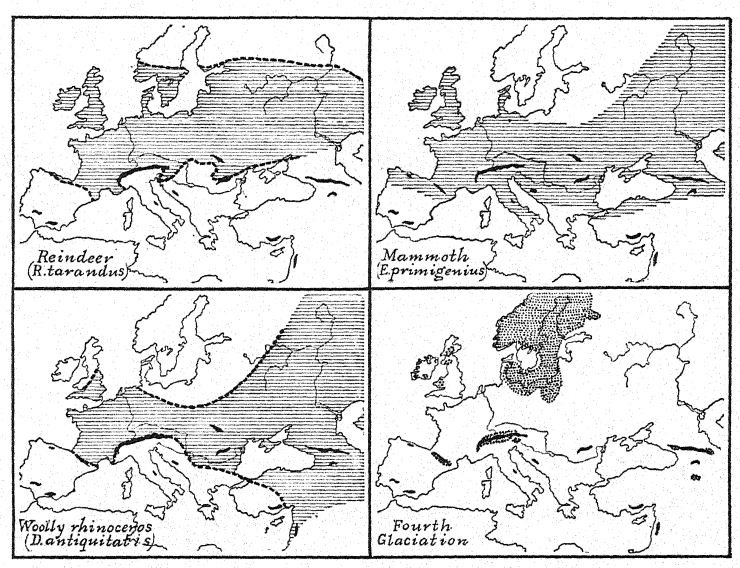
The extremely cold and moist climate of the fourth glaciation had passed, and a somewhat drier but still extremely cold climatic condition prevailed throughout western Europe. During the early Aurignacian the two northern types of lemming, the banded lemming (Myodes torquatus) Obi lemming (Myodes obensis), were still found along the upper Danube, as in the grottos of Sirgenstein, Ofnet, and Bockstein. From middle Aurignacian on through Solutrean times these denizens of the extreme north disappear from this region of Europe. Further [ p. 286 ] evidence of a dry, cold climate is found in the recurrence of dust-storms and in the great deposits of ‘newer loess’ beginning in certain parts of Europe at the very close of the Mousterian industry and extending through both middle and late Aurignacian and Solutrean times in all the region of the upper Rhine, along both shores of the Danube, and westward in the valley of the Somme, in northern France. This period is therefore believed to correspond with the Achen retreat of the great glaciers still covering the Alpine region.
Another striking proof of the amelioration of climate is the return of the flint workers to many of the open stations, old and new, in various parts of western Europe, the climate being more endurable because less humid. In Mousterian times the open stations were very rare and were perhaps visited during the summer season only ; in Aurignacian times they were more abundant, there being twelve open stations out of a total of about sixty stations thus far discovered ; in Aurignacian and Solutrean times the type station of Solutre was much frequented, and many other open camps are found in various parts of western Europe.
This is still the Reindeer Period; in fact, it is the typical ‘Reindeer Epoch’ of Lartet, and the predominant forms of life are the woolly mammoth and the woolly rhinoceros; but for a time the reindeer seems to have been less abundant, and Aurignacian times are marked apparently by a very greatly increased number of horses. The animal life throughout retains its northern or arctic character; the tundra species predominate, the hardy forms of the forests and meadows of Eurasia are next in number, and then are found a few of the steppe forms, with here and there forms characteristic of the Alps. The entire fauna of the Aurignacian may be summed up as follows:
The wild ass, or kiang, of the Asiatic deserts appears in late Aurignacian times in the region of the upper Rhine and upper Danube, as seen in the deposits of Wildscheuer, Thaingen, Kesslerloch, and Schweizersbild, and also there probably arrived in Europe at this time the Elasmothere (E. sibericum), a gigantic [ p. 287 ] rhinoceros, distinguished from all others that we have been considering by the entire absence of the anterior horn and by the possession of an enormous single horn situated on the forehead above the eyes, also by the elaborate foldings of the dental enamel, to which the name ‘Elasmo there’ refers ; its teeth were especially adapted to a grassy diet ; it apparently wandered into Europe from the arid grassy plains of central and western Asia, and its appearance is connected with the extensive deforestation accompanying the tundra and steppe periods of mammalian life.
Tundra Life.
- Reindeer, woolly mammoth, woolly rhinoceros, musk-ox (rare), arctic fox, arctic hare, arctic wolverene, arctic ptarmigan.
- Banded and Obi lemmings in lower Aurignacian only.
Alpine Life.
- Argali sheep, ibex, alpine ptarmigan.
Steppe Life.
- Steppe horse, kiang, central Asiatic ass.
Forest Life.
- Red deer, roe-deer, giant deer, brown bear, cavebear, wildcat, wolf, fox, otter, lynx, weasel.
Meadow Life.
- Bison, wild cattle.
Asiatic Life.
- Gave-hyaena, cave-lion, ? cave-leopard.
These periodic arrivals from central Asia suggest the existence of migration routes which may also have been followed by tribes of Palaeolithic hxmters.
There is no evidence at this time of the presence of the more characteristic animals of the steppes, such as the saiga antelope, the jerboa, and the steppe hamster, which enter Europe during the later period of Magdalenian culture. As an indication, perhaps, of the dryness of the climate we observe that the moose (Alces) is no longer recorded, although it reappears in western Europe in later Magdalenian times. The giant deer (Megaceros) appears in southern Germany with the early Aurignacian culture, but this would seem to be the time of its extinction, because it does not occur in association with any of the later industries. For a time the bison in Dordogne, in southern Germany, and in Austria appears [ p. 288 ] to be far more abundant than the wild cattle ; the latter animals are not recorded either by Schmidt or Dechelette in association with the Aurignacian culture, but they reappear in the moister period of Magdalenian times.
The remains of similar late Pleistocene mammals lie scattered over a large area in Britain, and we must conclude from their presence, obsen’es Dawkins,12 that Britain was still broadly connected with the mainland of Europe. This is proved by the occurrence of the mammoth fauna in various places now covered by the sea, as in Holyhead Harbor, off the coasts of Devonshire and of Sussex, and in the North Sea. On the Dogger Bank the accumulation of bones, teeth, and antlers is so great that the fishermen of Yarmouth have collected in their nets and dredges more than three hundred specimens. They belong to the bear, wolf, cave-hysena, giant deer, Irish elk, reindeer, stag, bison, urus, horse, woolly rhinoceros, mammoth, and beaver, and are to be viewed as the remains of animals deposited by river currents, as in the case of similar accumulations on land. Had they been deposited by the sea they would have been sifted by the action of the waves, the smaller being heaped together in one place and the larger in another. The carcasses had evidently been collected in the eddies of a river that helped to form the Dogger Bank, which now rises to within eight fathoms of the sea-level.
One of the animals of the Aurignacian period which is best known is the ‘horse of Solutré.’ Around the great Aurignacian camp at Solutre there accumulated the remains of a vast number of horses, which are estimated at not less than 100,000; the bones are distributed in a wide circle around the ancient camp, consisting of broken or entire skeletons compacted into a veritable magma, with which occur also remains of the reindeer, the urus, and the mammoth interbedded with all the types of Aurignacian implements. The majority of these horses belong to the stout-headed, short-limbed forest or northern type, measuring 54 inches (13.2 hands) at the withers, and about the size of the existing pony.'® The joints and hoofs were especially large, and [ p. 289 ] the long teeth and powerful jaws were adapted to feeding on coarse grasses ; the greater part of the remains arc those of horses from five to seven years of age. There is no evidence that the men of Aurignacian times either bred or reared these animals; they pursued them only for food. The discovery that the horse might be used as an animal of transport appears to have been made in the far East, and not in western Europe.
The animal and plant life of the Aurignacian station near Krems, on the Danube, above Vienna,14 includes a strong element of the tundra forms — the arctic fox, wolverene, mammoth, rhinoceros, musk-ox, reindeer, hare, and ptarmigan. The steppe fauna, on the other hand, is rare, including only the suslik, but not the saiga antelope or any of the other characteristic steppe types. The principal objects of the chase were not only the mammoth, which was extraordinarily abundant, but also the reindeer and wild horses ; the ibex is rare.
Obermaier observes that the chart of the geographic distribution of the Aurignacian shows this culture to belong essentially to the provinces surrormding the entire Mediterranean, from Syria (the grottos of Lebanon) through north Africa (Algiers) to Spain. It also has a strong development throughout France, entering middle and southern Germany and passing along the Danube to Austria, Poland, and soilthern Russia (Mezine) north of Kiev. There is no doubt that the mammoth hunters of Krems belonged in this wide-spread distribution ; the shells used for ornaments, which tmmistakably recall those of the Riviera, are only in part local from the neighborhood of Vienna; the larger part is from the Mediterranean. We may imagine that these shells passed through several hands among this race of nomadic hunters, and this is not surprising in view of the girdle which the Aurignacian stretched around the entire Mediterranean Sea.
¶ Discovery of the Crô-Magnon Race
The earliest discovery of a member of this race was that by Buckland, in the cave of Paviland, which opens on the face of [ p. 290 ] a steep limestone cliff, about a mile east of RhossiUy, on the coast of Gower, Wales.15 As described by SoUas, a painted skeleton, long known as the ‘Red Lady,’ was found in the kitchen rnidden which forms the floor of this cave; recent investigation has proved that this skeleton belongs to a man of the Crô-Magnon race; the associated implements are of Aurignacian type. Paviland cave is thus the first Aurignacian station discovered in Britain and marks the most westerly outpost of the Crô-Magnon race.
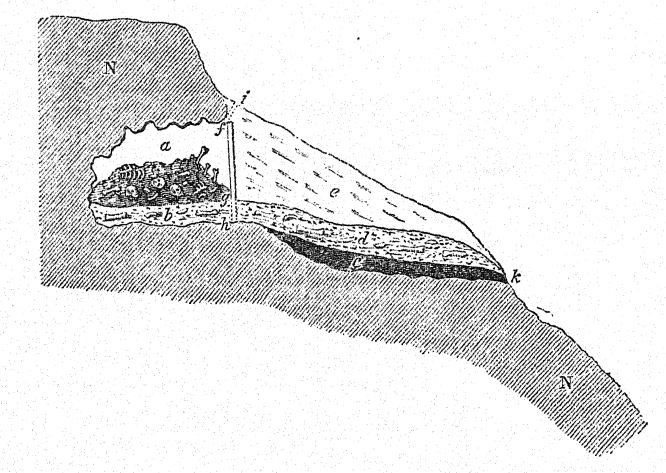
In 1852 the sepulchral grotto of Aurignac, on the nearest spur of the Pyrenees, in Haute-Garonne, was accidentally discovered by a laborer. It was almost filled with bones, among which were two entire skulls and many fragments, numbering altogether no less than seventeen skeletons of both sexes and of all ages. The mayor of Aurignac ordered all the bones to be taken out and reinterred in the parish cemetery. Thus, in 1860, when Lartet visited this grotto and determined it as the type station of a distinct industry, all the human remains had been lost beyond [ p. 291 ] recovery, and with them all possibility of learning to what race, culture, and geologic age they belonged. On a sloping terrace in front of the grotto was the hearth containing one hundred flint implements, mingled with the remains of a typical reindeer fauna.
In 1868 Lartet explored a grotto in the little hamlet of Crô-Magnon, near Les Eyzies, on the Vézère, where he found five skeletons, which have become the type of the great Crô-Magnon race of Upper Palaeolithic times. The grotto was accidentally discovered by workmen building a road in the Vézère valley. Here Lartet found the skeleton of an old man, now known as the ‘old man of Crô-Magnon’; then that of a woman, whose forehead bore the mark of a woimd from some heavy blow ; close to her lay the fragments of a child’s skeleton and near by those of two young men. Flint implements and perforated shells were found with these skeletons.
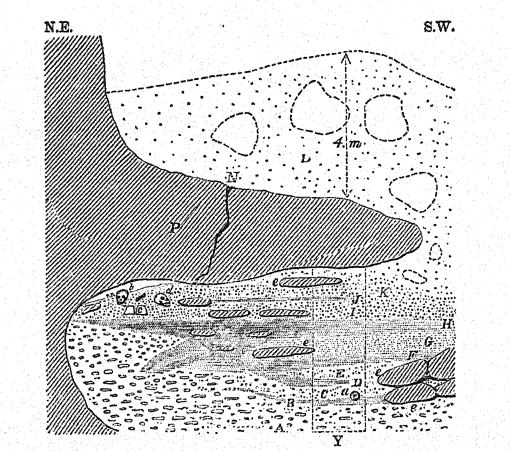
In May, 1868, the material was first described by Broca,16 his excellent account being later reprinted and amplified in the Reliquiae Aquitanicae of Lartet and Christy.17 Broca referred to [ p. 292 ] these skeletons as incontestable proofs of the contemporaneous existence of man and the mammoth. The associated mammalian life was that of the reindeer and the industry is now known to be of the Aurignacian stage. In his classic original description of this type Broca remarks upon the high stature, the face very broad in relation to its height, with very long and very narrow orbits; the large and markedly dolichocephalic skull, with an unusually large brain capacity, noting that the brain capacity of the Crô-Magnon woman surpasses that of the average male of to-day; the forehead correspondingly broad, vertical, convex on the median line ; the bones of the limbs robust, and the shin-bones flattened transversely ; altogether a very high racial type of skeleton belonging to the species Homo sapiens.
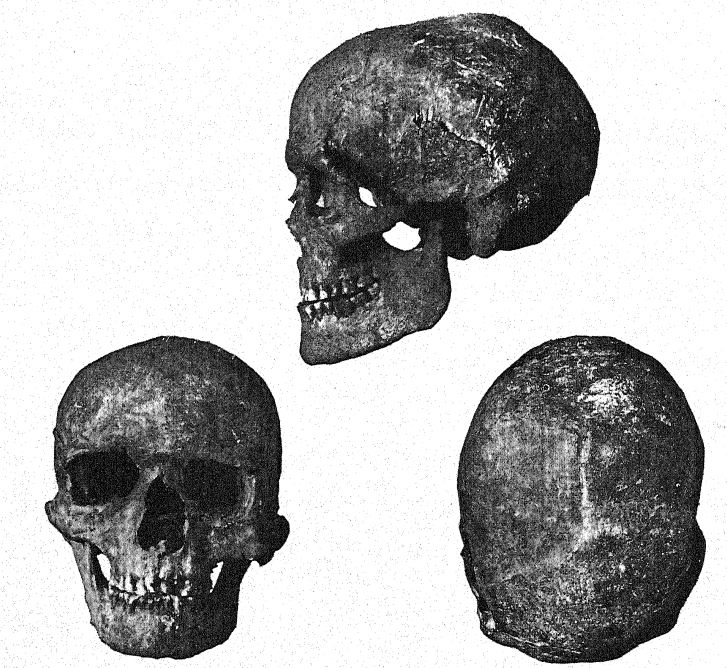
[ p. 293 ]
Verneau,18 in his description of the Crô-Magnon type, emphasizes the disliarmonic form of the head, for the dolichocephalic form of the skull is combined with a face very broad for its height, and this, in fact, is the unique and most distinctive feature of the Crô-Magnon race. The cheek-bones are both broad and high. It is curious that in this face, so broad across the cheek bones and cheek arches, the space between the eyes is small, the nose is narrow and aquiline, and the upper jaw is noticeably narrow; it is no less remarkable that this upper jaw projects forward, while the upper part of the face is almost vertical, as in the highest types of Homo sapiens. The eye sockets, which are remarkably broad, are rather shallow, and their angles are but slightly rounded off, so that the form suggests a very long rectangle; the mandible is thick and strong, and the chin massive, [ p. 294 ] triangular, and very prominent ; the marks of muscular attachment denote great muscular development around the thick, strong jaws, in which the parts for the attachment of the vertical muscles are -unusually large. I would add, says Verneau, to these essential characteristics the surprising capacity of the cranium, which Broca estimated as at least 1,590 c. cm. The majority of these features are found in almost all of the skulls of the Crô-Magnon race in the Grottes de Grimaldi. The top [ p. 295 ] view of the skull is unusual on account of the extreme proininence of the eminences of the parietals, which give the skull a pentagonal effect when seen from above. The eyebrow ridges show decided prominences above the orbits but disappear completely in the median line and at the sides and thus differ totally from those in the Neanderthal head.
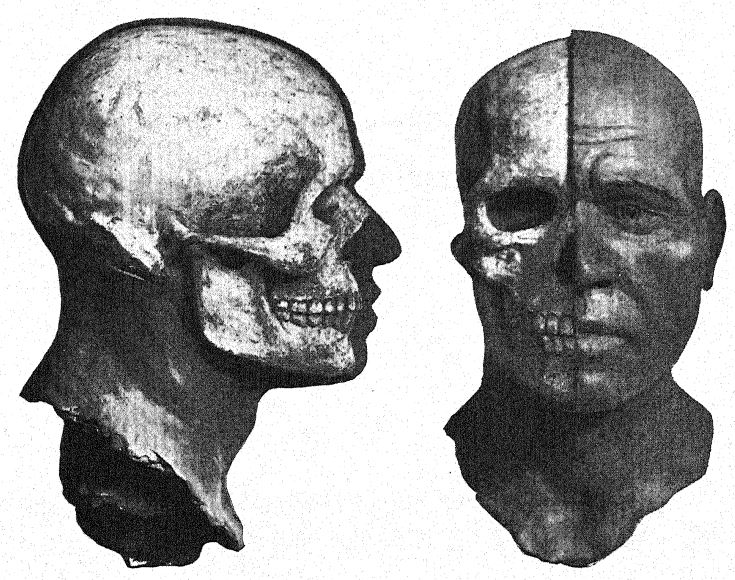
DISCOVERIES CHIEFLY OF THE CRO-MAGNON AND GRIMALDI RACES[4]
Referred to Aurignacian Times
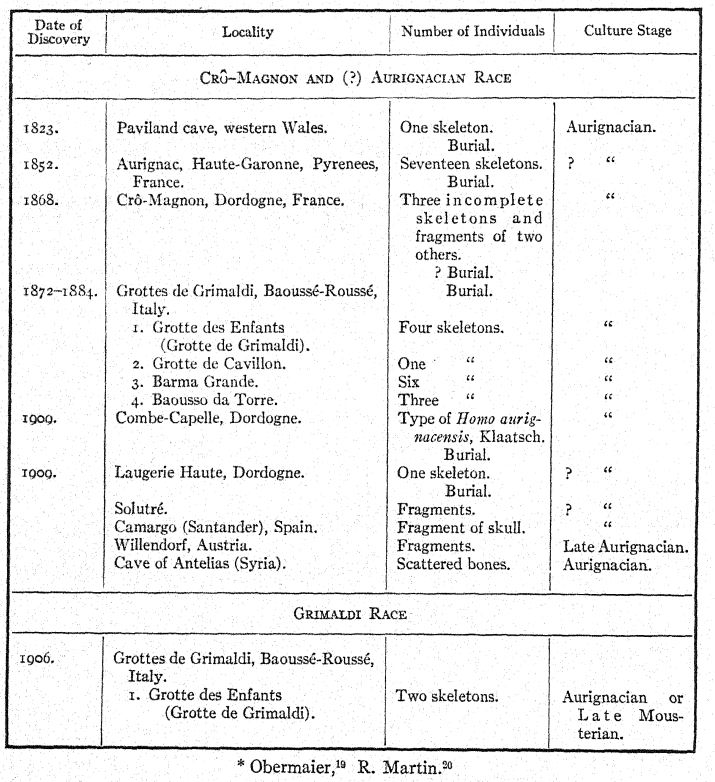
Of the numerous skeletons foimd in the Grottes de Grimaldi, or Baousse-Roussé, near Mentone, the one first discovered is most widely known as the ‘man of Mentone,’ which was found in the Grotte de Cavillon, in 1872, by Riviere; hence this is sometimes spoken of as the Mentone race ; but, as Verneau shows, while the measurements of the skulls of Baousse-Roussé show some variety, they do not exceed what might be expected in individual variation, and we conclude that all the men of tall stature found in the Grottes de Grimaldi belong to the Crô-Magnon race, which is not to be confused with the very distinct dwarf Grimaldi race discovered in the Grottes de Grimaldi by Verneau, in 1906, in a lower level than any of the skeletons of the Crô-Magnon type.
In Aurignacian times, lofty stature seems to have been a general characteristic of this race, but there appears to have been a gradual decrease in height, so that in later industrial times the race in general is somewhat smaller in stature. The heights are as follows;
| Crô-Magnon type of Dordogne | 1.80 m. | 5 ft. 10 3/4 in. |
| “ woman slightly inferior in size. | ||
| Baousse-Roussé, Grottes de Grimaldi. | ||
| Adult males of | ||
| Cavillon | 1.79 m. | 5 ft 10 ½ in. |
| Barma Grande II | 1.82 m. | 5 ft. 11 ½ in. |
| Baousso da Torre II | 1.85m. | 6 ft. 3/4 in. |
| Barma Grande I | 1.93m. | 6 ft. 4 in. |
| Grotte des Enfants | 1.94 m. | 6 ft. 4 ½ in. |
| Average | 1.87 m. | 6 ft. 1 ½ in. |
| Woman of Barma Grande estimated at | 1.65 m. | 5 ft. 5 in. |
| Youth of 15 years, Barma Grande, estimated at | 1.65 m. | 5 ft. 5 in. |
The woman had not reached complete development. As there is a variation of 6 inches in the height of the various male [ p. 296 ] skeletons, it is evident that we cannot reach a trustworthy conclusion from a single subject ; but there would seem to be quite a disparity in height between the sexes.
The very large skeleton from the Grotte des Enfants, measuring ( 6 feet 4 ½ inches, was found associated with the remains of the reindeer, 15 feet below the surface, from which it would appear probable that the skeleton antedates the Aurignacian skeleton of Laugerie Haute, and even of Crô-Magnon. Thus the so-called man of Mentone may be an ancestor of the race which was found in Crô-Magnon and other regions of Dordogne. It is these men of great height, found in Barma Grande and the Grotte des Enfants, which Verneau selects for his description of the primitive members of the Crô-Magnon race, which at this time lived along the Riviera and in the valley of the Vézère and later spread over a vast area in western Europe. It is probable [ p. 297 ] that in the genial climate of the Riviera these men obtained their finest development; the country was admirably protected from the cold winds of the north, refuges were abundant, and game by no means scarce, to judge from the quantity of animal bones found in the caves. Under such conditions of [ p. 298 ] life the race enjoyed a fine physical development and dispersed widely.
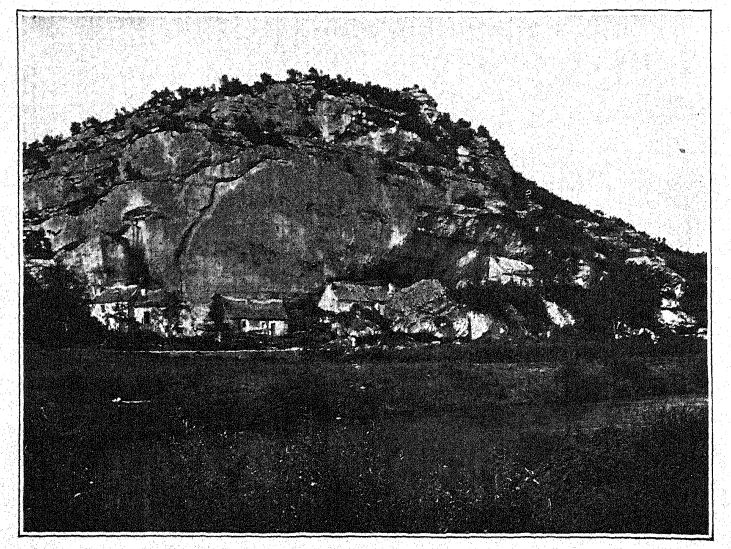
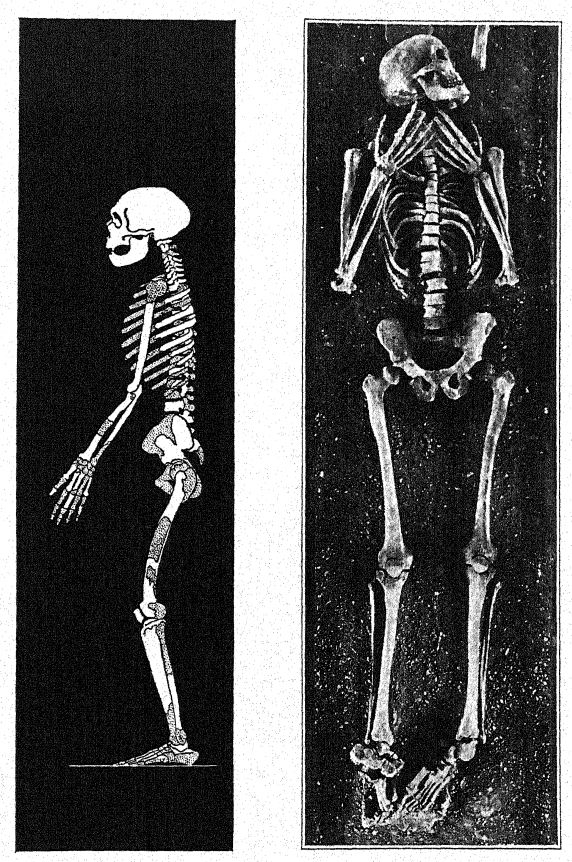
With an average height of 6 feet 1 ½ inches, these cave-dwellers may be said to demonstrate one of the most striking traits of the Crô-Magnon race. In the proportions of the limbs and in the great size of the upper part of the chest these men are removed from the modern European type and approach some of the African negroid types, although there is not the least resemblance to the negro type in the skull or in the dentition. In contrast with the Neanderthals are three characters of the limbs : the leg was very long in comparison with the arm ; they show a remarkable lengthening of the forearm in proportion to the upper arm and a still more remarkable lengthening of the lower leg or shin-bone in proportion to the thigh-bone ; the tibia has an index of 81-86 per cent as compared with the femur, which is relatively greater than that of the average modern European, with a tibiofemoral index of 79.7 per cent. This long shin-bone indicates that these men were swift of foot, quite in keeping with their undoubted nomadic habits and wide distribution. The flatness of the tibia, which is strongly marked in 62 per cent of the skeletons, may well be due to the habit of squatting while engaged in fashioning flints and in other industrial occupations. The leg, long in comparison with the arm, and the thigh-bone, strongly developed, are both characters of a hunting race. The foot has a very protruding heel, but the sole and the toes are [ p. 299 ] of moderate length. The hip-girdle is of a type which has nothing negroid about it, but is as fine as that of the most civilized whites ; it is marked by its strength, the augmentation of all the vertical and transverse diameters, and the reduction of the anteroposterior diameters. The shoulders are exceptionally broad. The fact that the arms are relatively short as compared with the legs is also a high racial character. The upper arm is very robust, and in some cases the left arm is more largely developed, in others the right.
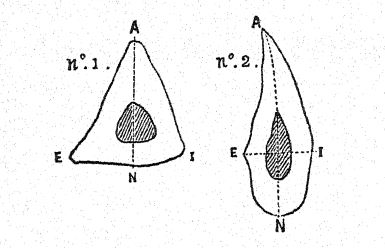
In all the skulls from these grottos near Mentone, the face shows the essential features of the Crô-Magnon race, its breadth being due to the development of the cheek-bones and the zygomatic arches, for the upper jaws are narrow, and the nose is thin or leptorhine. At the root the nose shows a marked depression, but it rises immediately to a considerable prominence; it thus undoubtedly had an aquiline profile. The orbits always present the form of a long rectangle, so characteristic of the race along the Vézère. All these characters leave no doubt of the racial affinity of the skeletons from the Grottes de Grimaldi with the original Crô-Magnon type. It must be concluded, therefore, that certain peculiar features noted in the type of the 'old man of Crô-Magnon’ are purely individual, and that we are not justified in assuming the admixture of a foreign element to account for the weakness of some characteristics which we notice in the majority of the Crô-Magnon subjects from the caves of Grimaldi.
The highly evolved characters of the skeleton in this race are in keeping with the extraordinarily great cranial capacity. Broca estimated the 'old man of Crô-Magnon’ as having à cranial capacity of 1,590 c. cm., and in the female the brain is estimated at 1550 c. cm. Vemeau estimates the five large male skulls of Crô-Magnon type at Grimaldi as having an average capacity of 1,800 c. cm., the lowest being 1,715 c. cm., and the highest 1,880 c. cm. This race, observes Keith,21 was one of the finest the world has ever seen. The wide, short face, the extremely prominent cheek-bones, the spread of the palate and [ p. 300 ] a tendency of the upper cutting teeth and incisors to project forward, and the narrow, pointed chin recall a facial type which is best seen to-day in tribes living in Asia to the north and to the south of the Himalayas. As regards their stature the Crô-Magnon race recalls the Sikhs living to the south of the Himalayas. In the disharmonic proportions of the face, that is, the combination of broad cheek-bones and narrow skull, they resemble the Eskimo. The sum of the Crô-Magnon characters is certainly Asiatic rather than African, whereas in the Grimaldis the sum of the characters is decidedly negroid or African.
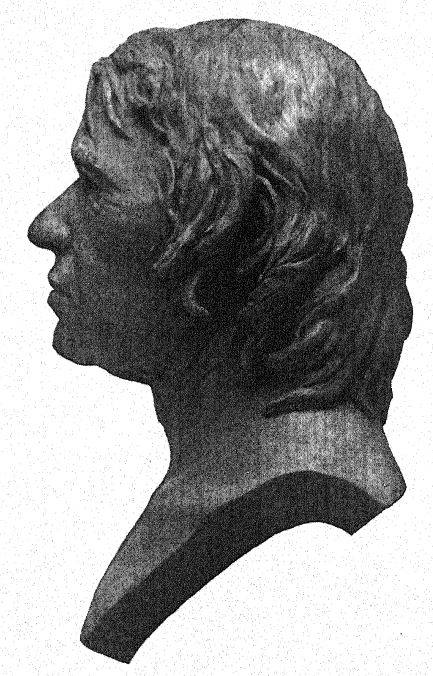
We shall trace this great race through the Solutrean and [ p. 301 ] Magdalenian stages of the Upper Palaeolithic and consider its disappearance and possible distribution at the close of Magdalenian times. It will then be interesting to consider the evidence of the survival of the descendants of this race in various parts of western Europe and possibly among the primitive inhabitants of the Canary Islands, known as the Guanches.

¶ Evidence of Other Races
It is a mooted question whether the Crô-Magnons were the only people inhabiting Europe in early Aurignacian time or whether there were also two other races, the Grimaldi and the Aurignacian. As we have seen in the preceding pages, there is no evidence that the negroid Grimaldi race ever became established [ p. 302 ] in Europe ; the idea of the presence of a negroid race has taken the fancy of archaeologists like Breuil and Rutot, when seeking an African, Egyptian, or Bushman analogy in certain phases of early Aurignacian art ; but it rests merely on the slender evidence afforded by the isolated skeletons of a woman and of a boy.
The case of the x\urignacian race is different ; this is held by competent anatomists (Klaatsch,22 Keittf23) to be distinct from the Crô-Magnon race and to bear some resemblance to the Brünn (Bribe, Predmost, [?] Galley Hill) race which, we know, became established in central Europe certainly as early as Solutrean times, if not before.
The so-called Aurignacian race (Homo sapiens aurignacensis), described as a subspecies of existing man, is based upon a type found in the shelter of Combe-Capelle near Montferrand, Perigord, in the summer of 1909 by O. Hauser.24 It is commonly known as the ‘Combe-Capelle’ man from the scene of its discovery, or as the Aurignacian man (Homo aurignacensis) ; if a subspecies, it certainly belongs to Homo sapiens. The adult male skeleton was discovered lying undisturbed in the lowest stratum of an Aurignacian industry and was carefully disinterred by Klaatsch and Hauser. It was apparently a case of ceremonial burial; a great number of unusually fine flints of early Aurignacian type was found with it, also a necklace of perforated shells (Littorina, Nassa) ; the limbs were bent.25 Water saturated with lime had dripped upon the burial-place, resulting in the remarkable preservation of the skeleton. This skeleton is compared by Klaatsch with that of Brünn, Moravia, and of Galley Hill, near London, from which he concludes that it represents a distinct type, the Aurignacian race ; the stature is 5 feet 3 inches, as compared with 6 feet I inches, the average in the five Crô-Magnon males of Grimaldi; the brain case is well arched and falls within the variation limits of Homo sapiens. The skull is very long and narrow, the cephalic index being 65.7 per cent; in some points it shows a striking similarity to that of Brünn, in others it varies from it in the direction of the recent European form ; the face is not narrow nor is it prognathous ; the lower jaw is small with a [ p. 303 ] well-developed chin. Klaatsch finds many characteristics resembling those of the Crô-Magnon race, including the Chancelade type which is a late Crô-Magnon. He suggests that the Crô-Magnon t^pe may be considered a further development of the Aurignacian. It seems probable that the Aurignacian man is a member of the true Crô-Magnon race and that additional evidence is required to establish it as distinct. Schliz26 considers that this, skull is an intermediate form between that of the Crô-Magnon and the Brünn race, an indication that these two races were undergoing a parallel development.
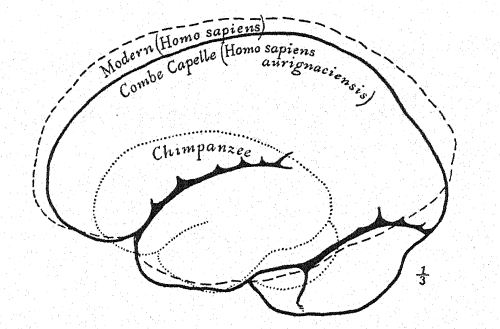
¶ Burial Customs
Similar customs of burial prevailed widely in Aurignacian times, as we have observed from the use of color in the Paviland interment of western Wales and in the Brünn interment of Moravia. This is a feature seldom found in the Neanderthal burials, although the latter are accompanied by signs of great reverence and by an abundance of ornaments and finely finished flints. Up to the present time the races of the Upper Palaeolithic have been studied with far less anatomical precision than those of the Lower, and the attribution of many of the burials to the Crô-Magnon race awaits verification.
[ p. 304 ]
We have little record of the Paviland burial except that the skeleton, was that of a man of the Crô-Magnon race and colored red. Of the burial of Aurignac we have no record other than that seventeen skeletons were placed close together ; it would appear that this compound burial may have been the sequel of a battle or, less probably, that of an epidemic. The type skeletons of the Crô-Magnon race were simply lying on the surface of a deep shelter ; thus there has always been some doubt as to their exact archaeological age ; a large number of perforated shells was found among the bones, as well as pendants of ivory.
The most remarkable Crô-Magnon burials of undoubted Aurignacian age are those of the Grottes de Grimaldi ; the infant skeletons found here are neither colored nor decorated, but occurred with a vast number of small perforated shells (Nassa), evidently forming a sort of burial mantle. Similarly, the female skeleton was enveloped in a bed of shells not perforated ; the legs were extended, while the arms were stretched beside the body; there were a few pierced shells and a few bits of silex. One of the large male skeletons of the same grotto had the lower limbs extended, the upper limbs folded, and was decorated with a gorget and crown of perforated shells; the head rested on a block of red stone. In the ‘man of Mentone,’ found in 1872, the body rested on its left side, the limbs were slightly flexed, and the forearm was folded; heavy stones protected the body from disturbance ; the head was decorated with a circle of perforated shells colored in red, and implements of various types were carefully placed on the forehead and chest. Similarly in the burial of Barma Grande three skeletons were found placed side by side in a layer of red earth containing a large quantity of peroxide of iron; two of the skeletons rested on the left side, the limbs extended or slightly flexed ; the forehead and chest and one of the limbs were encircled with shells.
In the burial of the so-called Aurignac man of Combe-Capelle, described above, the limbs were outstretched and the body was decorated with a necklace of perforated shells and surrounded [ p. 305 ] with a great number of fine Aurignacian flints. It appears that in all the numerous burials of these grottos of Aurignacian age and industry of the Crô-Magnon race we have the burial standards which prevailed in western Europe at this time.
We must infer that the conception of survival after death was among the primitive beliefs, attested by the placing with the dead of ornaments and of weapons and in many instances of objects of food. It is interesting to note that the grottos and shelters were so frequently sought as places of burial, also that the flexed limbs or extended position of the body prevailed throughout western Europe into Neolithic times, as well as the use of color through the Solutrean into Magdalenian times. It is probable from their love of color in parietal decorations, and from the appearance of coloring matter in so many of the burials, that decoration of the living body with color was widely practised, and that color was freshly applied, either as pigment or in the form of powder, to the bodies of the dead in order to prepare them for a renewal of life.
¶ Aurignacian Flint and Bone Industry
As pointed out in the introduction of this chapter, the geographical distribution of the early Aurignacian industry is especially interesting in its bearing upon the routes by which the Crô-Magnon race entered Europe. “We can hardly contemplate an origin directly from the east,” says Breuil,27 “because these earlier phases of the Aurignacian industry have not as yet been met with in central or eastern Europe.” A southerly origin seems more probable, because the Aurignacian colonies appear to surround the entire periphery of the Mediterranean, being found in northern Africa, Sicily, and the Italian and Iberian peninsulas, from which they extended over the larger part of southern France. In Tunis we find a very primitive Aurignacian like that of the Abri Audit of Dordogne, with implements undoubtedly similar to those of Chatelperron, in France. Even far to the [ p. 306 ] east, in the cave of Antelias, in Syria, as well as in certain stations of Phoenicia,28 culture deposits are fomd which are characteristically Aurignacian. Again, in southern Italy implements of typical Aurignacian form, tending toward the superior stage, are found in the grotto of Romanelli, Otranto.
On the other hand, in favor of the theory of local or autochthonous evolution of this culture is the direct succession described below of Aurignacian prototypes and early Aurignacian implements above the older Mousterian layers in the various stations of Dordogne. In fact, the relation of the Aurignacian industry to the preceding Mousterian is one of the most important in the history of Palaeolithic archaeology, because of the change of race which occurred at this time. How far is it derivative and autochthonous, how far is it new and influenced by invasion and the handicraft of a new and superior race?
First, as for transition from the older culture, it is important to note throughout that the ‘Aurignacian retouch’ is identical with the Mousterian ; this retouch is on one side of the flake only and gives it a short, abrupt, and blunt edge. As we shall see, it is essentially different from that discovered by the Solutrean flint workers and employed in Solutrean times, a superior technique which produced a sharp, thin edge, many of the implements [ p. 307 ] being dressed on botb sides. On the other hand, Breuil concludes that the early Aurignacian industry can only in part be derived from the late Mousterian and that it is partly due to the invasion of a race which ranks much higher in the scale of intelligence than the Neanderthal.
Art.
- Microlithique, microlith.
- Burin, graver (first appearance).
Industrial.
- Coup de poing, hand-stone (rare and degenerate).
- Pointe, point.
- [4:1]Chatelperron (curved).
- double-pointed.
- Racloir, scraper.
- convex.
- concave.
- straight.
- double-edged.
- triple-edged.
- Grattoir, planing tool.
- Pergoir, drill, borer.
- Couteau, knife, blade.
- Enclume, anvil stone.
- Percuteur, hammer-stone.
War and Chase.
- Pointe, point.
- Pierre de jet, throwing stone.
- Couteau, knife, blade.
- Pointe de lance, bone lance-heads.
The pure early Aurignacian industry is seen in the regions of Dordogne and the Pyrenees in the layers of Chatelperron, GermoHes, Roche au Loup, Haurets, and Gargas. The cave of Gudenushöhle, near Krems, in Lower Austria, exhibits a very primitive phase of the early Aurignacian. Here numerous small flints were foimd, resembling those foimd at Brive by the Abbés Bardon and Bouyssonie; similar microliths are also found at Pair-non-Pair, Gironde, at various stations in Dordogne, and at the Grottes de Grimaldi, on the Riviera, in layers of corresponding age.
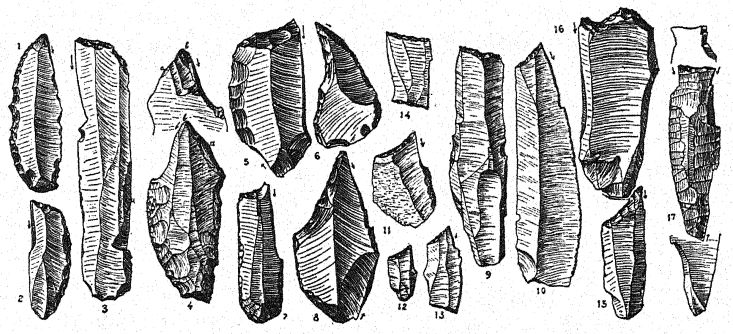
The chief invention of this stage is the ‘Chatelperron point’ (Fig. 149), a direct development from the curved point of the Abri Audit (Fig. 151) and a dominant type of the early Aurignacian culture. Small almond-shaped ‘coups de poing’ are [ p. 308 ] still met with at Chatelperron and a few other localities, but Breuil suggests that these may not be real examples of Aurignacian industry but implements carried off from older stations.
The use of elongated flakes is another feature of this early industry, but the retouch of the edges cannot compare with the fine ‘grooved retouch’ of the middle Aurignacian; as yet the flakes are thick and large. Many of the scrapers are ‘keeled’ (grattoirs carénés).
An entirely new implement appears in addition to the triangular and elongate flakes of flint shaped into points and scrapers of forms ; this is the primitive graving-tool, or burin, which at first is quite rare, but which we know was designed by the Crô-Magnon artists for their early engravings on stone (Fig. 149).
A fourth highly distinctive feature of the early Aurignacian is the use of a variety of implements of bone and horn consisting chiefly of javelin points and drills and of coarse, spatula-like tools.
In the middle Aurignacian the flake industry reaches its perfection of form and technique; the edges of the flakes are shaped all around with the ‘grooved retouch’ resulting in symmetrical forms such as the oval, double-ended ‘points,’ the leaf-shaped ‘points,’ and the double scrapers; this, in fact, is the culmination of the ‘Aurignacian retouch,’ which afterward begins to decline. The retouch of the long flakes is [ p. 309 ] fine and parallel, but as yet the flakes themselves are generally thick and hea\y’, so that their ends are, perforce, much broader than those of the Solutrean and Magdalenian fashion. One of the most distinctive forms of this middle Aurignacian industry is the ‘keeled scraper’ (grattoir caréné) with an abruptly grooved retouch (Fig. 150 ).
Art Implements.
- Microlithique, microlith.
- Burin, graven [5]
- Ciseau, chisel
- Gravette etching tool (first appearance). [5:1]
New Industrial Implements.
- Pointe, point (leaf-shaped).
- Grattoir caréné, keeled scraper. [5:2]
- Percoir, drill, borer.
- curved (first appearance). [5:3]
- Couteau, knife, blade.
- curved-in edges. [5:4]
- Poinçon, awl (bone).
New Implements of War and Chase.
- Pointe à cran, shouldered point (stone).
- Pointe de sagaie, javelin point (bone).
Still more significant in connection with the rapid artistic development of these people is the remarkable increase in the number and variety of graving-tools, including numerous curved gravers. Almost all the chief types of gravers (burins) have now been invented, and tools of bone have become extremely numerous and varied. To engraving and linear design have been added the art of sculpture and the primitive use of color (Breufl,29 Schmidt30).
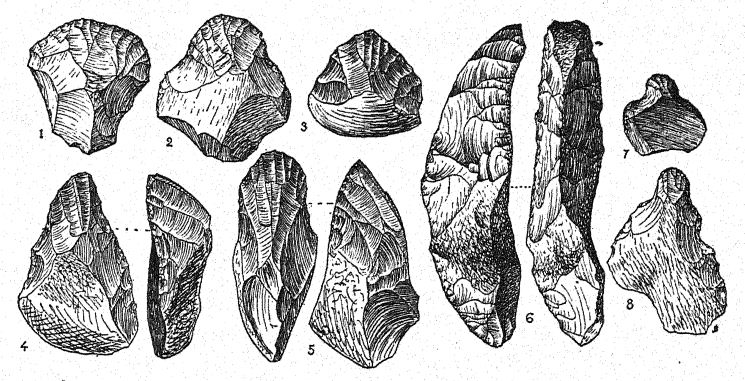
After Breuil. About two-fifth actual size. 1, 2, 3. Short and broad types appearing in the middle Aurignacian, 4, 5. More elongated types of the advanced middle Aurignacian from Crô-Magnon, Dordogne. 6. Elongated type (pic) of the close of the middle Aurignacian. 7, 8. Small graitoirs with handles, suitable for sculpture.
In the Dordogne region this evolution of the middle Aurignacian is exemplified at Le Ruth, Le Roc de Combe-Capelle, and the principal layers of the Abri Audit as well as at the shelter of Laussel. It is well developed also at Le Trilobite, on the headwaters of the Seine.
[ p. 310 ]
Art.
- Microlithique, microlith.
- Burin, graver.
- Ciseau, chisel (of stone and bone)
- Gravette, etching tool.
- Pic, pick (triangular or quadrangular, for sculpture).
Ceremonial.
- Bâton de commandement, ceremonial staff (first appearance).
New Industrial Implements.
- Grattoir, planing tool
- long but not thick. [6]
- Aiguille, needle (bone, first appearance).
New Implements of War and Chase.
- Lance and spear head types, of stone:
- (a) Pointe à cran, shouldered point.
- (b) Pointe à soie, tongued point (Font Robert type).
- (c) Pointe de lau- laurel-leaf rier(?), point(?).
- Couteau, knife, blade (bone, first appearance).
In the late Aurignacian (Breuil,31 Obermaier32) there is a notable departure from the Mousterian fashion of chipping the flakes ; even the distinctive blunt Aurignacian retouch’ is somewhat weakened; but at the same time the work on the elongated flakes becomes more facile and skilful. For delicate, artistic work there appear extremely small implements or ‘microliths’ of various shapes.
The early and middle Aurignacian ‘point’ and the ‘grattoir,’ sharpened all aroimd, as well as the incurved flake become less frequent. The grattoirs, or planing tools, are somewhat higher and narrower than those of the early Aurignacian but not very different in form; two forms of grattoir are recognized, one long and not very thick, the other high and keel-shaped (grattoir caréné).
Among the perfoirs a curved form is very characteristic, and we also note a variety of small knives, or couteaux.
The inventive genius of this people is displayed in the rapidly increasing variety of flint implements designed for fishing or for the chase. Toward the end of the Upper Aurignacian there appears the shouldered spear head (pointe à cran), and also a [ p. 311 ] lance form of which the most perfect types have been found at Wniendorf, in Austria, and at Grimaldi, on the Riviera. More or less sporadically there appear specimens of the tongued spear heads (pointes à soie), such as are found at Spy, Font Robert, and Laussel. This type of flint is constantly found associated with rudely formed prototypes of the Solutrean laurel-leaf point.
Decorative art has now become a passion, and graving-tools of great variety of shape, curved, straight, convex, or concave, diversified both in size and in style of technique, are very numerous. We may imagine that the long periods of cold and inclement weather were employed in these occupations. The use of the reindeer horn is developing, and the decoration of the bone with very fine lines drawn by the microlithic tools is at times very remarkable. Here appear the earliest examples of the socalled bâton de commandement, which is supposed to have served as a ceremonial staff or wand ; it is made of the reindeer antler with a great hole bored at the point where the brow tine unites with the main beam ; some of these bâtons are ornamented with rude engravings, but not as yet with sculpture.
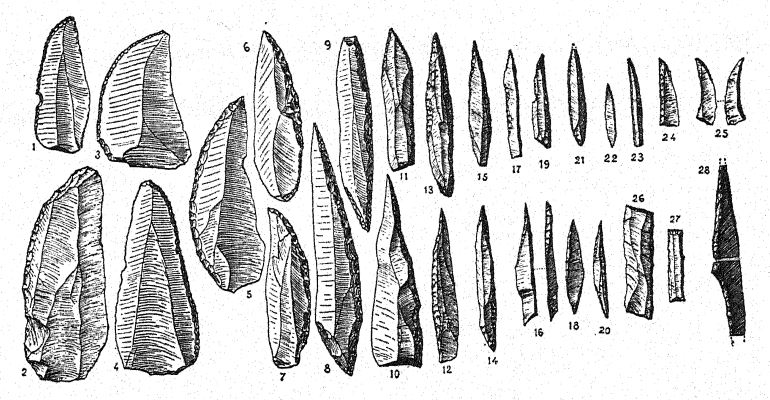
[ p. 312 ]
Strong and very sharp graving-tools were also needed for the sculpture out of ivory and soapstone of such human figures and figurines as the statuettes found in the Grottes de Grimaldi and at Willendorf and still more powerful tools for such work as the large stone bas-reliefs of Laussel. At this time the Crô-Magnons were also fashioning stronger tools for the engraving of animals in stone, for shallow forms of bas-relief on the walls of the caves, and for other animal outlines. The most evolved animal figures of this period arouse the thought of Magdalenian art in its beginnings.
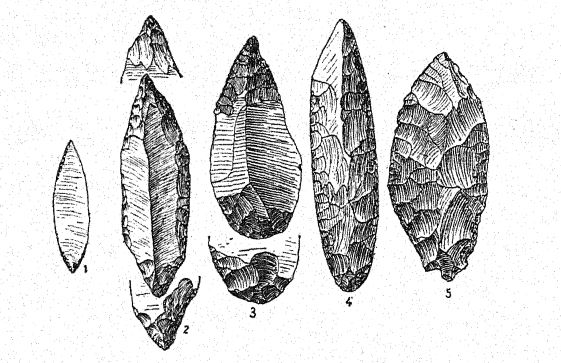
As this industrial evolution widens it is apparent that we witness not the local evolution of a single people but rather the influence and collaboration of numerous colonies reacting more or less one upon the other and spreading their inventions and discoveries. These people were essentially nomadic and no doubt carried the latest types of implements from point to point or bartered them in trade. Thus there is not only a definite succession in such places as Dordogne, but in more remote regions the form of the implements may take on some important [ p. 313 ] differences.33 There are also other localities where the industry seems for a while to be suspended; thus in the Cantabrian Alountains of Spain we find only the early and the late Aurignacian.
Stations similar in culture to those of Dordogne extend northward into Germany and Belgium and eastward into Austria and Poland. Thus the characteristic flint spear heads, known as the pointe à soie and pointe à cran extend from Laussel along the Vézère to Wiliendorf, in Austria; and the female figures of Baoussé-Roussé (Grimaldi) and of Wiliendorf represent the same stage of evolution as the large stone basrelief of Laussel. Again, we observe some relations between the Aurignacian cultures of Austria and of the Italian peninsula, such as the pointe à cran, derived from the gravette and found both in various stations of northern Italy and at Wiliendorf. In western Russia the Aurignacian station of Mezine, Chernigov, shows clearly the types of the superior Aurignacian in the graving of bone and ivory, in the small bâtons recalling those of Spy, in Belgiurn, and of Brassempouy, in southwestern France, in the large bone piercers perforated at the head, suggesting the primitive needles from the shelter of Blanchard, and in the degenerate statuettes resembling the type of Brassempouy.
¶ Distribution of the Aurignacian Industry
When the general geographic distribution of the Aurignacian (Fig. 153) is compared with that of the Mousterian (Fig. 125) it is surprising to find how many of the stations are identical; it would appear as if the Crô-Magnons had driven the Neanderthals from their principal stations over all of western Europe for the pursuit of their own industries and of the chase. We have already spoken of the invasion of the Mousterian stations along the Riviera, in the Pyrenees, in the Cantabrian Alps, and along the Dordogne and the Somme; this occupation also extends along the Meuse, the Rhine, and the Danube ; but, whereas there are only six stations in all Germany of imquestioned Mousterian age, there are more than double that number in [ p. 314 ] Aurignacian times. The Crô-Magnons entered the grottos of Sirgenstein and Rauberhöhle, near the headwaters of the Danube; northwest of Sirgenstein they established the open ‘loess’ station of Achenheim, west of Strasburg ; in the lower layers of the ‘newer loess’ was also the station of Volklinshofen, south of Achenheim; along the middle Rhine were the ‘loess’ stations of Rhens and Metternich, and to the far north, close to the borders of the Scandinavian glacier, was the somewhat doubtful Aurignacian station of Thiede. The Crô-Magnon men entered the Sirgenstein grotto and scattered the implements of their culture above the ‘lower rodent layer,’ composed of the Obi lemming, and also left remains of the woolly rhinoceros, the woolly mammoth, the stag, and the reindeer on the floor of [ p. 315 ] the cavern. The Upper Aurignacian also extends down the Danube as far as Willendorf, and possibly to Brünn, Moravia, which last, however, may be of Solutrean age. Altogether between seventeen and twenty Aurignacian stations have been discovered in the region north of the Danube and along the Rhine.
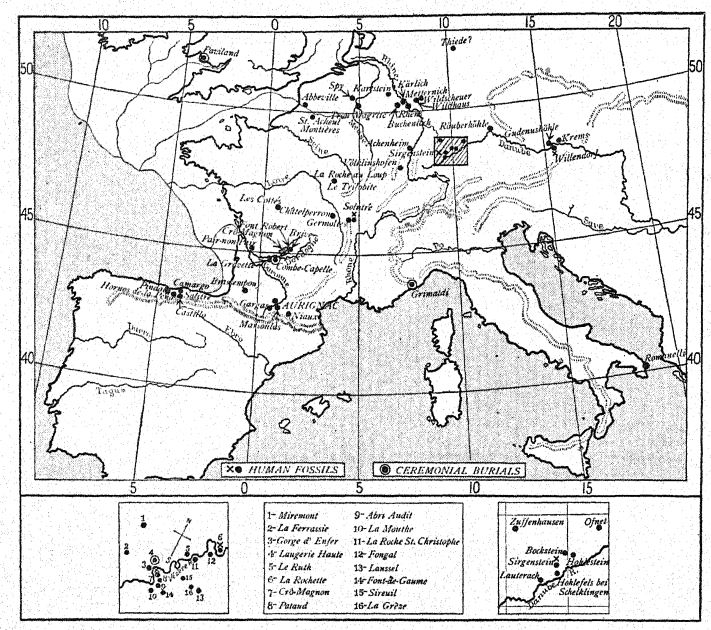
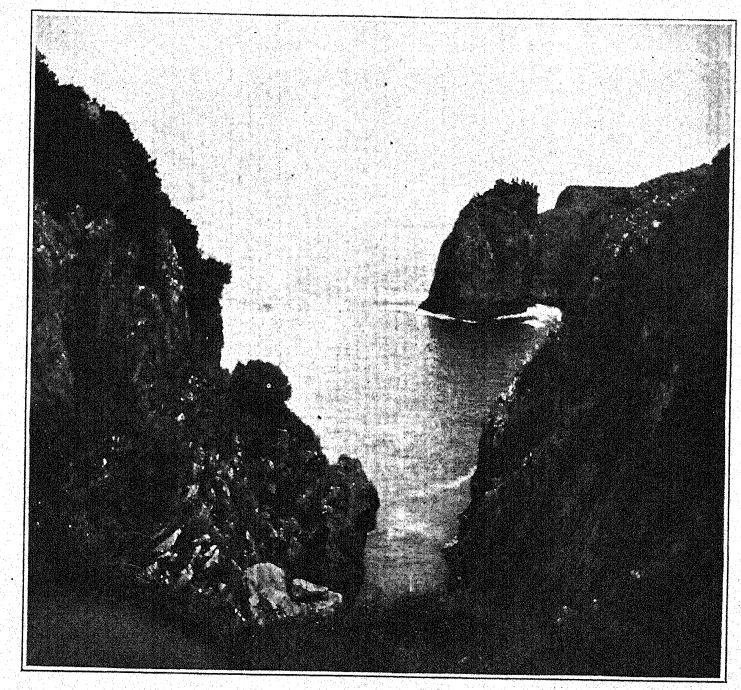
¶ Aurignacian Art
The strongest proof of the unity of heredity as displayed in the dominant Crô-Magnon race in Europe from early Aurignacian until the close of Magdalenian times is the unity of their [ p. 316 ] art impulse. This indicates a unity of mind and of spirit. It is something which could not pass to them from another race, like an industrial invention, but was inborn and creative. These people were the Palaeolithic Greeks; artistic observation and representation and a true sense of proportion and of beauty were instinct with them from the beginning. Their stone and bone industry may show vicissitudes and the influence of invasion and of trade and the bringing in of new inventions, but their art shows a continuous evolution and development from first to last, animated by a single motive, namely, the appreciation of the beauty of form and the realistic representation of it.
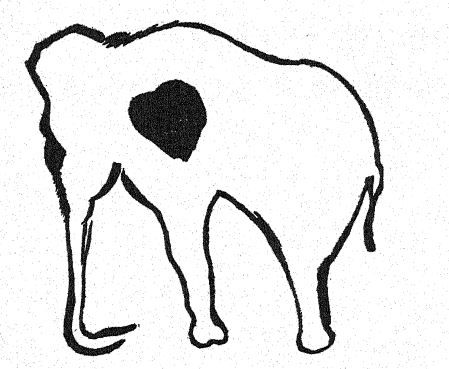
This art, as first discovered by Lartet and further made known through the brilliant studies of Piette and Breuil, is industrial (l’art mobilier), consisting of the decoration of small personal belongings, ornaments, and implements of stone, bone, and ivory. According to the later researches of Sautuola, Riviere, Cartailhac, Capitan, and Breuil it is also mural or parietal (l’art parietal), consisting of drawings, engravings, paintings, and bas-reliefs on the walls of caverns and grottos. It remained for Breuil especially to demonstrate that the mobile and the parietal art are identical, the work of the same artistic race, developing along [ p. 317 ] closely similar lines, step by step. Thus the art becomes a new means not only of interpreting the psychology of the race but of establishing the prehistoric chronology.
¶ Dating ot the Art
One of the first questions which rises in our mind is this — how is this art dated; how can these steps be positively determined?
The age of these engraved or painted designs on the walls of the caverns is determined in a number of ways described by Breuil.36 The simplest method is where the wall designs of one period are covered by the archaeological layers of succeeding periods. This has been observed in four cases, as at Pair-non-Pair, Gironde, where primitive engravings of horses, caprids, and bovids are buried under flints characteristic of the late Aurignacian mingled with bones of the mammoth, rhinoceros, lion, hyaena, bison, and reindeer. Again, the deeply engraved bison on the wall of the grotto of La Grèze, Dordogne, is found beneath a talus of Solutrean flints associated with remains of the bison, reindeer, and rhinoceros. In the Grotte de la Mairie, Dordogne, are found several finely engraved middle Magdalenian figures of animals buried beneath late Magdalenian implements associated with the reindeer fauna.
Very important, indeed, is the age of the sculpture and basreliefs found in Laussel. The human sculptures are determined to be of late Aurignacian age, because they are buried in an early Solutrean talus. The splendid wall sculptures of the series of horses in the Cap-Blanc shelter, near the Laussel shelter, are shown to be of middle Magdalenian age, because of the upper Magdalenian strata which covered and partly concealed them.
In other instances we can date a drawing in a cavern by the period at which the opening was closed ; for example, the cave of La Mouthe, Dordogne, was closed in by a Magdalenian layer of flints which touched the roof and firmly sealed up the entrance until recent times. Again, at Gargas, Hautes-Pyr6nees, we [ p. 318 ] know that the last occupation by the Crô-Magnons was near the end of Aurignacian times, as indicated by a hearth filled with late Aurignacian flints and with the remains of the bear, hyaena, horse, and reindeer; the opening of the grotto was buried beneath these foyers, which obstructed the entrance until the cave was rediscovered at a comparatively recent date. Also [ p. 319 ] at Marsoulas, Haute-Garonne, there are two hearths, one late Aurignacian, the other late Magdalenian ; the grotto was then dosed until recent times. The grotto of Niaux, on the Ariege, which contains fine examples of drawings of middle Magdalenian times at a distance of 1,800 feet from the entrance, was protected for a long period by a lake 6 feet deep and several hundred feet long. At Altamira, near Santander, the superb frescoed ceiling was buried, long before Neolithic times, by the closing up of the entrance, which was rediscovered only about thirty years ago.
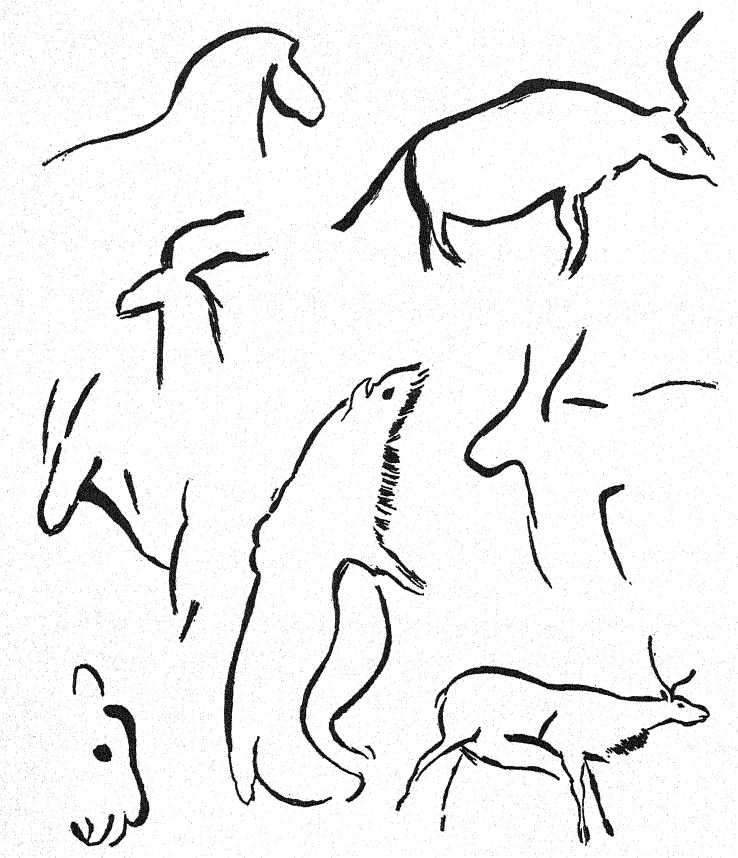
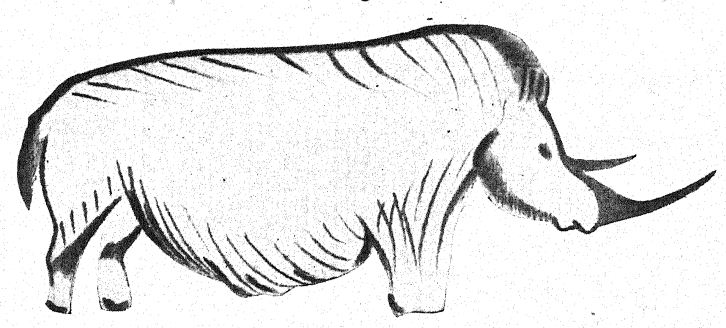
A third method of dating the art is still more significant ; it is through a similarity in the engravings on bone, found in the old hearths associated with flints, to the mural decorations which are foxmd upon the walls. Thus, at Altamira, engravings on bone associated with Solutrean and Magdalenian flints enabled Alcalde del Rio and Breuil to date the engravings on the limestone wails. Hence, in grottos which have never been closed up and which have been frequented at different times from the Palaeolithic to the present epoch one observes that the mural designs in the caverns are invariably accompanied by Upper Palaeolithic implements with a similar style of decoration ; and this is the case at Font-de-Gaume, Combarelles, Portel, Mas d’Azil, Castillo, Pasiega, and Hornos de la Peña. The bone engravings [ p. 320 ] of the female red deer found at Altamira are identical in their artistic period with those found on the walls of the same grotto. The excavations at Castillo, where numerous shoulderblades of the deer were found engraved in the same style as those of Altamira, prove that all these engravings and drawings are to be referred to ancient Magdalenian rather than to upper Solutrean times. The engravings upon the walls in the grotto of Hornos de la Peña, of Aurignacian times, are dated through the discovery at the base of the layer of Aurignacian flints of an engraved equine figure similar to the engravings at Altamira.
A fourth method applies to those not infrequent cases when two or three designs are superposed one upon the other, from which it necessarily follows that the underlying designs must antedate those above.
Through the application of these four methods Breuil has succeeded in dating all the steps in the advance of art from Aurignacian into Magdalenian times.
¶ Engraving, Painting, And Sculpture
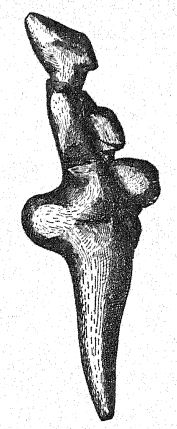
In the archaic drawings of the caverns of Pair-non-Pair, La Grèze, and La Mouthe most of the animal figures are somewhat heavily and deeply engraved ; the proportions are not true ; the head is usually too small, with a large, short body which is often lightly modelled, resting on thin extremities. Quadrupeds are frequently represented with but two legs, as in the case of the mammoth. That the powers of observation were only gradually trained is shown by the fact that details which in later drawings are well observed are here overlooked ; the profile drawings of animals, with one fore leg and one hind leg represented, are quite like those of children.
Progress toward a true representation of animal form in drawing begins very early ; even in middle Aurignacian times primitive drawing and engraving commences to replace sculpture. Both the flint ‘burins’ and the engravings on the walls of the grottos show that the beginnings of drawing may be [ p. 321 ] traced back to early Aurignacian times. While the Palaeolithic artists early in the Aurigiracian had obtained a certain facility in plastic work, their drawings, which are solely contours — somewhat imperfect and deeply engraved lines — show a gradual development. The degree of skill attained in late Aurignacian times we know from the cngracing of a horse on a stone fragment from Gargas, and from a sketch of the hinder quarter of a horse found in the cave of Hornos de la Peña, which is engraved on the frontal bone of one of the wild horses ; the latter is strikingly similar to one of the engravings fovmd at the entrance to the same grotto. The engravings on a slab of slate of the heads of two woolly rhinoceroses37 (Fig. 161) probably belong to the late Aurignacian. Similar attempts are found in the Abri Lacoste. Ornamentation develops in the middle Aurignacian, but retains a simple geometric character.
The parietal art on the walls of the caverns, mostly deep engravings, consists of stiff profiles in single lines and in red or black coloring. The animals represented are the ibex, the horse, the bison, and rarely the mammoth. The caves where these are found are Pair-non-Pair, La Grèze, La Mouthe, Bernifal, Font-de-Gaume, Altamira, and Marsoulas. Crucibles for grinding the color are found in the grotto of Marsoulas, the color being made by grinding up the red and yellow oxides of iron.
The development of art during the whole Aurignacian is continuous and is undoubtedly the work of one race ; Breuil considers it the work certainly either of the tall Crô-Magnons or of the small Grimaldis ; there is, however, no evidence of the survival of the Grimaldi race, and we may safely attribute this entire art development to the Crô-Magnons.
[ p. 322 ]
The creative spirit manifested itself along many different lines. In the fashioning of bone in early Aurignacian times there begins a new industry capable of great possibilities; out of combinations of lines there develop geometric figures ; in animal figures there is an attempt at simple symmetric relations, but a full, free composition is not attained. With further in working with bone and ivory, we find in the middle Aurignacian the first plastic representations of the human figure in the round.
The Crô-Magnon artist undertook this piastic work, choosing chiefly for his subject the female figure. These small plastic probably designed as idols; the figures are often misshapen; in the face the eyes frequently are not indicated at all; in some cases the ear is indicated; they recall the style of the modern cubists. More care is given to the sculpture of the form of the body than of the face. The ivory statue known as the Venus of Brassempouy lies at the base of the middle Aurignacian ; of the same epoch are the female statuettes of Sireuil, and the torso from Pair-non-Pair, whereas the soapstone figurine of Mentone and the ivory statuettes of Trou Magrite, Belgium, belong to the late Aurignacian. The spread of these idols, which are altogether characteristic of the earlier period of the Upper Palaeolithic, is traced eastward to Willendorf, Austria, and to Brünn, Moravia.
Breuil’s great contention is a certain similarity to north African art, which would seem to agree with his theory that the Crô-Magnon people followed the southern shores of the Mediterranean, bringing with them the Aurignacian industry and the glyptic art of the female statuettes similar to those of baked [ p. 323 ] clay which are found along the valley of the Nile. These figurines have in common the great development of all the parts connected with maternity, and in some eases a coiffure or headdress very much like that found in the most primitive Egyptian work. The extreme corpulence of all the figurines has been compared with the ‘steatopygy,’ or development of what are politely known as the ‘posterior curves,’ of the female in many African races. But only one of these Aurignacian figurines is truly ‘steatopygous’; the others are simply corpulent, a condition due to eating large quantities of fat and marrow, and probably to a very sedentary life. It is noteworthy that none of the male figures in drawing and sculpture is corpulent. While the art of the statuettes appears to come to a close in late Aurignacian times, it may extend into the Solutrean at Brünn, Moravia, and at Trou Magrite, Belgium. With due regard for analogies, it would rather appear probable that this archaic sculpture was autochthonous.
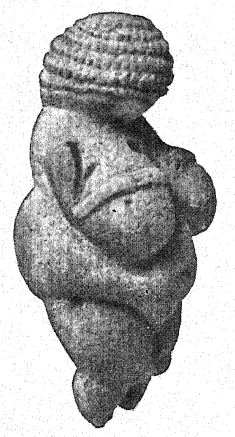
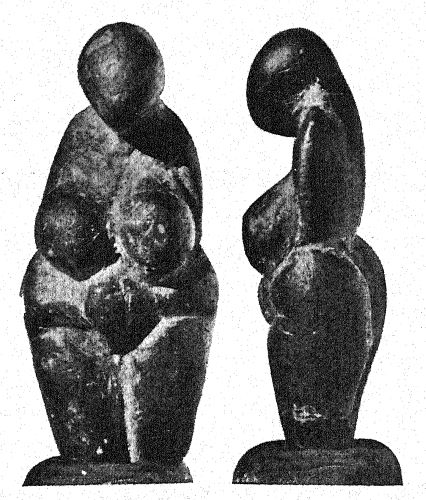
[ p. 324 ]
The art of engraving and drawing was almost certainly autochthonous, because we trace it from its most rudimentary beginnings. This northern art developed from the beginning of Upper Palaeolithic times over the whole of southwestern France and in the northwest of Spain, being contemporaneous with the descent of the alpine fauna from the Pyrenees and the Alps and the presence all over western Europe of the tundra fauna. It was, by preference, an animal art, begun by the Aurignacians but largely suspended in Solutrean times.
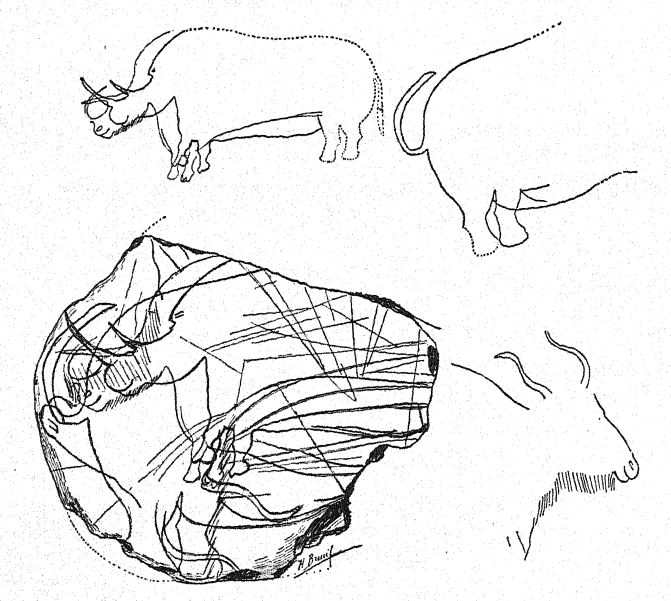
Painting38 also had its birth in the Aurignacian, in the simple contours of the hand pressed against a wall surface or outlined with color, accompanied by primitive attempts at linear drawing in color and painted groupings ; for example, the crude outlines of the bison in the grotto of Castillo are of Aurignacian age, also the [ p. 325 ] black linear designs of the deer and of the ibex in the cavern of Font-de-Gaume, Dordogne, the striking red linear design of the mammoth in the grotto of Pindal, in northern Spain, representing the animal as with two limbs, and the red outlines of wild cattle in Castillo. Breuil also attributes to Aurignacian times the spirited figure of the woolly rhinoceros in red ochre in the cave of Font-de-Gaume, as well as the outline of the stag in red color.

We are impressed throughout with three qualities in this Aurignacian design: first, the very close observation of the animal form; second, the attempt at realistic effect produced with very few lines ; third, the element of motion or movement [ p. 326 ] in these animals. For example, the two heads of the woolly rhinoceros in the slab engravings of the Trilobite grotto (Fig. 161) are remarkably correct in proportion ; there is an attempt with fine lines to indicate the wool hanging along the lower surface of the head ; behind these two figures is the rump of an elephant with the tail upturned, an adaptation of the artist to the form of the slate fragment ; the outlines of the feet both of the rhinoceros and the mammoth are remarkably accurate representations of these pachyderms.

In the more advanced development of draftsmanship in late Aurignacian times the engravings of these animals not merely approach the truth, but characteristic features are strikingly represented; and with a few sure lines the proportions of the body as a whole are better preserved, while the compUcated curves of the hoofs and of the head show very close observation.
[ p. 327 ]
In the grotto of La Grèze overhanging the Beune, a small tributary of the Vézère, was found an archaic Aurignacian outline of the bison deeply incised on the hmestone walls. The grotto of Gargas,[8] Hautes-Pyrenees39 is one of the most famous stations; it was entered in closing Mousterian times and was occupied at intervals during the Aurignacian stage. Beneath the Mousterian layer is a deep deposit of entire skeletons of the cave-bear without any traces of human industry. These layers lie beyond the grotto in the vast foyer which opens above into a great chimney, so that this is one of the true cavern habitations. The drawings along the walls of the cave include a large number of figures in a very imequal style, which belong chiefly to middle and upper Aurignacian times. Among these are two figures of birds, several mammals, a few primitive drawings of wild cattle, the bison, the ibex, and numerous representations of the horse. A long serpentine band of color meanders among some of these drawings. Most interesting are the silhouettes of the hand in black and red produced by pressiag the hand against the limestone wall and covering the surrounding surface with color. It would appear that the fingers were mutilated or cut off. at the middle joint, because one, two, three, and four of the fingers are wanting, but the thumb is never mutilated. This mutilation [ p. 328 ] of the hand may be compared with similar practices prevailing among some Australian tribes.
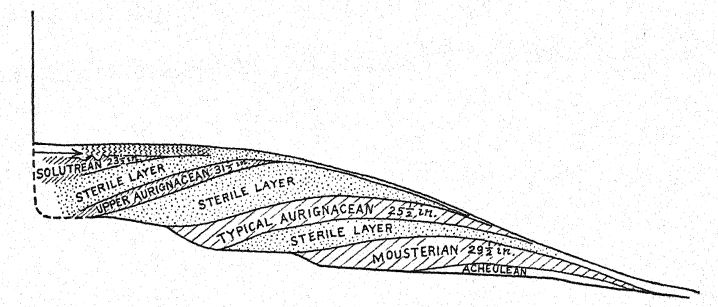
In the cavern of Marsoulas, on the headwaters of the Garonne, the conditions are altogether different; the parietal art here represents two cultural stages, the late Aurignacian and the late Magdalenian. There is a small entrance grotto with two hearths, corresponding to these two industries. The entrance to the cave is well up on the side of the hill, and the drawings which belong with the upper Aurignacian culture are somewhat damaged. Again, we find designs extending along the wall below the drawings. There are numerous outlines of the bison in black, the entire side of the body being covered with splashes of red.
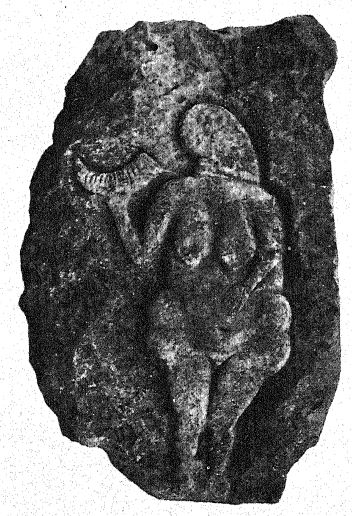
The great abri of Laussel, on the Beune, was first visited by the Neanderthals, for there are two Mousterian layers and above them two Aurignacian layers, the lower belonging to the middle Aurignacian industry and the upper to the closing Aurignacian period. This long, overhanging cliff of Laussel is a typical shelter, first sought in Acheulean times, revisited in Mousterian times, then again in middle or late Aurignacian, in Solutrean, and finally in Magdalenian times. As these successive layers rise they approach the shelter of the cliff, so that the Magdalenian flint workers were directly beneath the overhanging rock shelter, which opened outward toward the sun.
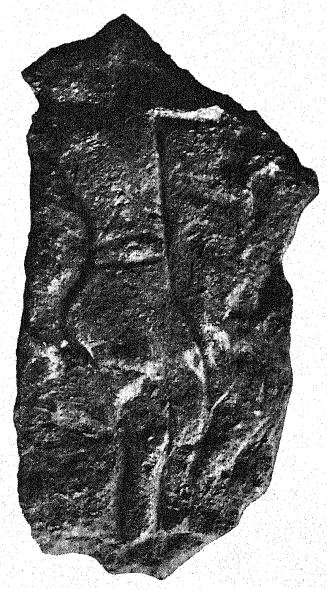
In the upper Aurignacian layer Lalanne discovered two basreliefs representing the figures of a man and of a woman. The [ p. 329 ] bas-reKef of the woman represents a nude figure holding the horn of a bison in the right hand; this is cut from a block of limestone with a relief of about two centimetres, and it measures forty-six centimetres in height ; with the exception of the head, the entire body is polished, and at certain points there remain traces of red coloring. A little farther on the artist had modelled the figure of a man in threequarter view in the attitude of casting a spear or of an archer drawing the bow ; the top of the head and the extremities of the limbs have been broken away ; the figure measures forty centimetres in height. These bas-reliefs of Laussel are regarded as sincere representations, for the artist has presented as accurately as possible the contemporary human figure ; both the man and the woman are- represented in motion. On the technique employed in this primordial sculpture, Doctor Lalanne observes that we find at Laussel a series of tools perfectly adapted to attain this result, many of which would the face of a boulder within the have been inexplicable unless found to occur in connection with the sculpture itself. It is curious to note how many analogies there are between the flint utensils of the primitive sculptor and those of the sculptors of our own day. First, we find tools designed to remove the rock, there are points, pickaxes, chopping tools for shaping the rock, saws, and coarse stone planers; all of these are perfectly adapted to the hand, from which we may conclude that our artist was right-handed. There is a great number of graving- tools, or burins, all forms being represented [ p. 330 ] —plain, double, fine, coarse, and combinations of the burin and grattoir. Some of the burins show the sharp-angled point centred at the extremity of a blade ; these are the ordinary types ; but in many the blade ends with a terminal retouch, which may be transverse, oblique, concave, or convex with the point to one side. The grattoirs, or planers, are equally numerous, with examples of all the known forms. Many of these are formed at the end of a blade ; a few are circular, and others are at the opposite end of a pointed blade ; the latter are particularly fine and are retouched around the entire edge. But the artist did not merely carve his subjects ; he also coated them with a paint made of ochre and manganese; he crushed his coloring matter on a palette of schist, and we have found one of these unbroken and still bearing the red and ochre colors. This palette is 10 ½ inches long and 6 inches wide ; it is oblong in form.
¶ Distribution of the Solutrean Industry
The period of the Solutrean industry is one of the most difficult to interpret in the whole prehistory of western Europe. The remains of this industry in several localities lie directly between those of the Aurignacian and the Magdalenian ; in others, • as at Solutre, they directly follow the Aurignacian. There is no doubt that this represents a very long and a very important epoch in Upper Palaeolithic development. From the cultural standpoint it represents a climax in the flint industry, but a period of suspension or of arrested development in art.
A glance at the maps of the Mousterian (Fig. 125), the Aurignacian (Fig. 153), and the Solutrean (Fig. 167) culture stations shows that the geographic distribution of the Solutrean is entirely unique ; whereas the Aurignacian culture may be said to girdle the Mediterranean, both on its southern and northern coasts, the Solutrean culture is absent in this entire region. The interpretation of this strange phenomenon offered by Breuil, that the Solutrean culture entered Europe directly from the east and not from the south, may be connected with the theory [ p. 331 ] that toward the end of Aurignacian times a new race from the central east was working westward through Hungary and along the Danube —a race of inferior mental type, but extremely expert in fashioning the flint spears and lances with what is known as the Solutrean ‘retouch.’ This may be the race of Brünn, Bribe, and Predmost, the remains of which are found in two localities associated with these highly perfected flint spear heads. Either by the invasion of this race or, more probably, by the invasion of the highly perfected spear-head industry itself, the type station of Solutré, on the Saone, was established and the region of Dordogne reached, where this industry progressed at twelve different stations.
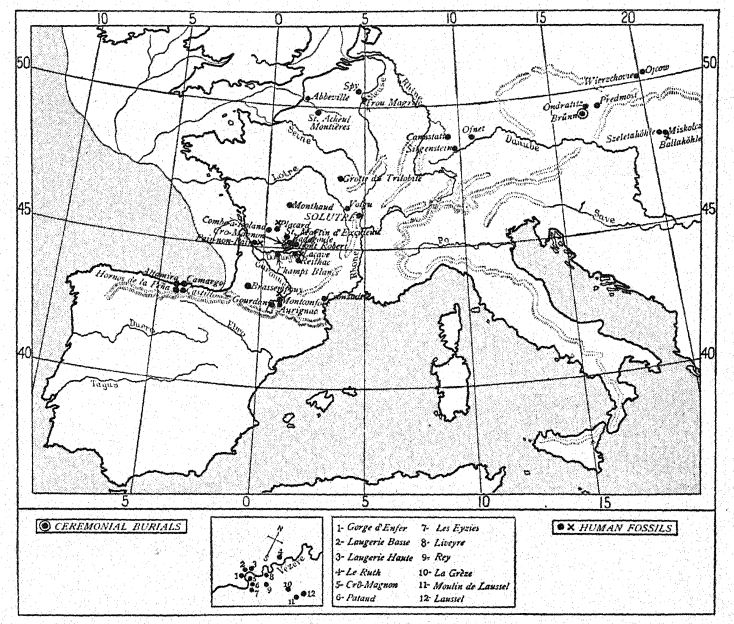
There is no doubt whatever that the new and entirely distinct Brünn race penetrated the Danubian region at this time, [ p. 332 ] but there is no evidence from skeletal remains that it reached France. It is quite possible that some of the flmt workers adept in the Solutrean ‘retouch’ migrated into the far western stations of Dordogne, bringing with them their beautiful technique, but without leaving traces of their skeletal remains through ceremonial burial. This unsettled problem, affords one of the many reasons why the anatomy of all the Upper Palaeolithic men of western Europe should be most carefully studied and compared.
Another mystery of Solutrean times is the arrest of the artistic impulse which had animated the Crô-Magnons throughout the entire Aurignacian. Evidences of artistic work in Solutrean times are very rare, and some dramngs which have been attributed to the Solutrean, as at Altamira, have now been referred to the Magdalenian. Is it possible that the Crô-Magnon race for a time suspended its artistic endeavor only to renew it under the different conditions of environment of Magdalenian times? Unfortunately, the Solutrean burials afford very little evidence on this point. One interpretation which may be offered is that the Solutrean was evidently a period of open-air life, and that the new implements of the chase of Solutrean type absorbed the industrial energies of these people, for the weapons were fashioned in enormous numbers. Consistent with this theory of climatic influence is the fact that the return of the severe climate of Magdalenian times, which crowded the men again into the shelters and grottos, was accompanied by a renewal of the artistic development continuing from the point where it had been interrupted in closing Aurignacian times. That Aurignacian and Magdalenian art is the work of one race there can be no question whatever; that this race was the Crô-Magnon is now absolutely demonstrated.
The climate of Solutrean times is generally believed to have been cold and dry. In the region of Dordogne throughout this period the reindeer was still far more numerous than any other animal; so we may safely conclude that this was the principal object of the chase and of food; in fact, it would appear that the [ p. 333 ] reindeer were resident forms in the valley of the Vézère, hunted and consumed throughout the year.40 Here we also occasionally find the northern steppe or Obi lemming, an animal which at the same time extends along the borders of the Volga River toward southern Russia. It would appear that in Solutrean times in southwestern France there prevailed a dry, cold continental subarctic climate like that of the Caspian, Volga, and Ural steppes of the present day. With the mammoth and the reindeer occur a great variety of northern European forest forms —the true fox, the hare, the stag, the brown bear, the wolf, the bison, and the uras. Most interesting is the identification of the jackal belonging to the ancient species C. neschersensis. In the type industrial locality of Solutre the reindeer is very abundant in the fire-hearths associated with the lower Solutrean industry, but less abundant in the upper levels; an antelope, perhaps the saiga antelope, is said to be found among the crude engravings on bone.
¶ Solutrean Races
There were certainly two distinct races of men in Europe during Solutrean times, to the east the race of Brünn and to the west the race of Crô-Magnon. Remains attributed to the Crô-Magnons have been found in the Departments of Charente, Gironde, Lot, Haute-Garonne, Tarn, and Dordogne. But most of these remains are very fragmentary and cannot readily be determined racially. The fragments of ten skulls and a few other bones found in the Grotte du Placard, Charente, are attributed to late Solutrean and to early Magdalenian times and constitute one of the most exceptional discoveries which have thus far been made in France ; the interments probably date from the early Magdalenian (p. 380), but are probably of a race surviving from the Solutrean. The section of the cave deposit is from 23 to 26 feet in thickness and is highly instructive; it shows eight cultural layers, separated by layers of debris and succeeding each other in the following order :
[ p. 334 ]
8. Neolithic layer.
7-4. Magdalenian layers ; in the lowest layer is the ceremonial burial of four skulls.
3. Solutrean layer with shouldered points (pointes à cran) and a few laurel-leaf (points de laurier).
2. Solutrean layer with laurel-leaf points but no shouldered points; knives, grattoirs, scrapers, borers, in great numbers, together with javelin points and awls in bone and ornamented with notches, and fragments of red chalk and black lead found embedded with the Solutrean points.
1. Mousterian layer.
¶ Race of Brünn, Brüx, Predmost, and (?) Galley Hill
In 1871 a skullcap, now in the Royal Museum of Vienna, was discovered in the course of coal mining at Brüx, Bohemia. In 189141 a skeleton, apparently of the same race, was discovered at Brünn, Moravia, deeply embedded in loess along with bones of the woolly mammoth and other great Pleistocene mammals. In 1892 it was described by Makowsky,42 who a few years before had excavated from the loess sand in the neighborhood of Brünn the fragmentary skull now known as Brünn II. Both these skulls are of a somewhat low racial type, and for a long time they were regarded as transition forms between the Neanderthals and Homo sapiens, but in 1906 Schwalbe43 showed the afiinity between the skulls of Brüx and Brünn and at the same time their entire distinctness from the Neanderthal skull and their approach to lower forms of Homo sapiens. The chief distinction of these skulls is their extreme elongation or dolichocephaly, the ratio of width to length being 69 per cent in the Brüx skull, and 68.2 per cent in the Brünn skull. The latter ranks lower in racial type than the Australian negroids. The chief distinction from the Neanderthal skull is in the index of the height of skull. (51.22 per cent) and in the absence of the prominent ridges extending across the eyebrow region above the nose ;[9] the forehead, in brief, is more modem, the frontal [ p. 335 ] angle being 74.7 - 75 per cent.The brain capacity in this race is estimated, according to Makowsky,44 at 1,350 cxm… Both the Brüx and Brünn skulls are harmonic; they do not present the very broad, high cheek-bones characteristic of the Crô-Magnon race, the face being of a narrow, modern type, but not very long. There is evidence that the neck and shoulders [ p. 336 ] were powerful and muscular ; the prominence of the chin is pronounced ; the dentition is macrodont, that is, the last lower molar is of exceptionally large size; there was no prognatliism or protrusion of the jaws. The second Brünn skull (Brünn II) may represent a female type of the Brünn race, the cephalic index being estimated at 72 per cent.
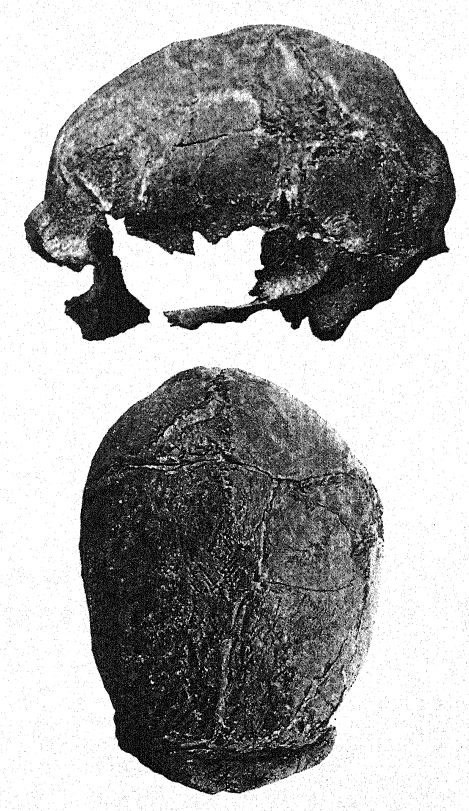
DISCOVERIES CHIEFLY OF THE CRO-MAGNON AND BRUNN RACES*
Referred to Solutrean Times
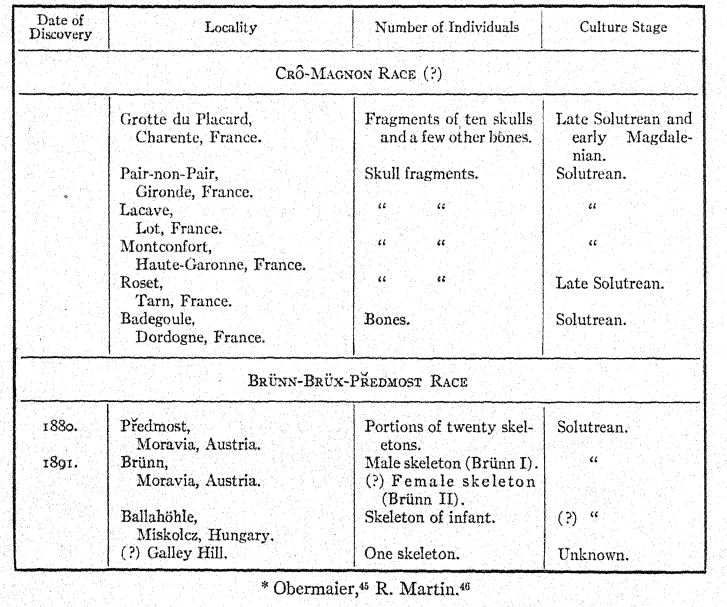
There is a possibility47 that the Brünn race was ancestral to several later dolichocephalic groups which are found in the region of the Danube and of middle and southern Germany. Schliz characterizes the Brünn skull as distinguished by the retreating forehead, by massive eminences above the orbits separated by a cleft in the median line, by broad, low orbits, and prominent chin. These characters are met with again in one of the dolichocephalic skulls found in the interment at Ofnet, [ p. 337 ] at the very close of Upper Palajolithic times. It would thus appear that the Brünn race is distinct from the Crô-Magnon race, that it represents a long-headed type which became established along the Danube as early as Solutrean times, and that it may possibly be connected with the introduction of some of the peculiar features of the Solutrean culture.
One of the skeletons of Brünn, found at a depth of 12 feet below the surface of the ‘loess,’ was lavishly adorned with tooth-shells, perforated stone discs, and bone ornaments made from the ribs of the rhinoceros or mammoth and from the teeth of the mammoth ; associated with these was an ivory idol, apparently of a male figure, of which only the head, the torso, and the left arm remain. The skeleton and many of the objects found with the sepulture were partly tinted in red. An ivory figurine belongs to the Ebumeen stage of Piette and appears to indicate that the burial was of Aurignacian rather than of Solutrean age.
The Predmost ‘mammoth hunters’ also probably belonged to this race. They are represented by the remains of six individuals excavated since 1880 at Predmost, Moravia, by Wankel, Kriz, and Maska. The bones were found in a very much shattered condition. Maska has since discovered a collective burial of fourteen human skeletons, with remains of six others; the bodies were covered with stones, but no flints or objects of art were buried with them. The dimensions of the limbs indicate a race of large stature. The skeletons were deeply buried in ‘loess,’ and above and below the rich archgeological layer were abundant ddbris of the mammoth, representing between eight and nine hundred specimens. Along with the numerous flints, including laurel-leaf spear heads of middle Solutrean type, were found other objects and even primitive works of art in bone and ivory. There is no question that the human remains belong to the middle Solutrean stage.48
With this race is also associated by many authors (Schwalbe, Schliz, Edaatsch, Keith) the Galley Hill skull, which was found in 1888, buried at a depth of 8 feet in the ‘high terrace’ gravels [ p. 338 ] 90 feet above the Thames.49 Sollas thinks it highly probable that the remains were in a natural position and of the same age as the high-level gravels and the Palaeolithic flints and remains of extinct animals which they contained, but Evans and Dawkins regard the Galley Hill man as belonging to a long-headed Neolithic race interred in a Palaeolithic stratum. The gravels of the ‘high terrace’ in which the Galley HiU skull was buried are by no means of the geologic antiquity of 200,000 years assigned to them by Keith they are probably of Fourth Glacial or of Postglacial age, and lie within the estimates of Postglacial time, namely, from 20,000 to 40,000 years.
The antiquity of the Galley Hill cranial type has been maintained with ability by Keith. The skull is extremely long or hj’perdolichocephalic, the cephalic index being estimated by Keith at 69 per cent;51 the brain capacity is estimated at between 1,350 c. cm. and 1,400 c. cm. ; the cheek-bones are not preserved, so that no judgment can be formed as to this most distinctive character of the Crô-Magnon race. With this Galley Hill race Keith also compares the Combe-Capelle, or Aurignacian man of Klaatsch,®^ although he mistakenly considers the Combe-CapeUe man of much less geologic antiquity. He continues: “Thus, while the writer is inclined to agree in provisionally assigning the Gombe-CapeUe man to the Galley HiU race, he beUeves that further discoveries will show that the Combe-CapeUe man belongs to a branch marked with certain negroid features.”
¶ Solutrean Flint Industry
The ‘Solutrean retouch’ marks one of the most notable advances in the technique of flint working ; it is altogether distinct from the ‘Aurignacian retouch,’ which is an heritage from the Mousterian.53 The flint is chipped off by pressure in fine, thin flakes from the entire surface of the implement, to which in its perfected form the craftsman can give a thin, sharp edge and perfect symmetry. This is a great advance on the abrupt Aurignacian [ p. 339 ] retouch, in which the flint is chipped back at a rather blunt angle to make a sharp edge. According to de Mortillet, the Solutrean method of pressure made possible the execution of much more delicate work.
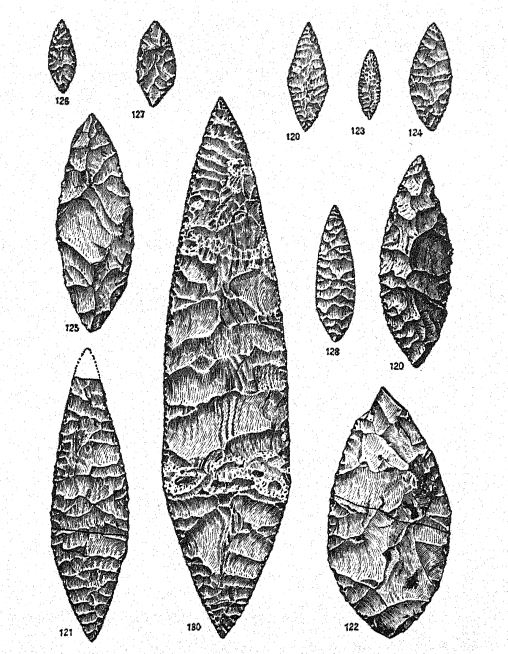
The question at once arises, did this industrial advance take place in France or was it an invention brought from the east? On this point Breuil observes54 that in the highest Aurignacian [ p. 340 ] levels in Belgium, in Dordogne, and at Solutre the Solutrean technique becomes faintly apparent either in the ‘stem’ points (pointes à soie) of Font Robert, La Ferrassie, and Spy or in the double-edged points tending toward the laurel-leaf type of the Solutrean, but that all the other implements remain purely Aurignacian.
Relations and Subdivisions of Solutrean Culture
Lower (Early) Magdalenian.
- Prototypes of bone harpoons.
- Beginnings of animal sculpture.
- Absence of any trace of the laurel-leaf spear heads of Solutrean times.
Upper (Lak) Solutrean. - Typical shouldered points (pointes à cran)— elongate flakes worked on one or both sides and notched. Small laurel-leaf spear heads.
- Bone javelin points, awls, and needles, very finely worked. Placard. Lacave.
Middle (High) Solutrean. - Large ‘laurel-leaf’ spear heads worked on both sides. Climax of Solutrean flint industry. Placard.
Lower (Proto-) Solutrean. - Primitive ‘laurel-leaf’ and ‘willow-leaf’ spear heads, most of them worked on only one side. Grotte du Trilobite.
Transition from Aurignacian. - Pedunculate spear heads (pointes à soie) of primitive Font Robert type.
- Climax of human sculpture.
As to the chief source of Solutrean influence, the same author remarks that, since this culture is entirely wanting in central and southern Spain, in Italy, in Sicily, in Algeria, and in Phoenicia, we should certainly not look to the Mediterranean for its origin but rather to eastern Europe ; for in the grottos of Hungary we find a great development of the true Solutrean, while so far the Aurignacian has not been found here, although we do find traces of the earlier transitional stages below the levels of the true laurel-leaf points. We must admit, therefore, that in all probability the Solutrean culture reached Europe from the east and that its source is as mysterious as that of the Aurignacian, which, as we have seen, was of southern and probably of Mediterranean origin. It is not impossible that the [ p. 341 ] evolution of the laurel-leaf point took place in Hungary, for it was certainly not evolved in central or western Europe.
At Predmost, in Moravia, we observe an advanced Aurignacian industry which had adopted a Solutrean fashion in its spear heads. Here the laurel-leaf implements are few, while the implements of bone are abundant; but in the Solutrean stations of Hungary there are no bone implements. As the Solutrean technique comes to perfection the laurel-leaf spear head, so characteristic of the full Solutrean industry, is created and is met with in Poland, in Hungary, in Bavaria, and then in France, where the industry extends southward to the west and east of the central plateau. In France it appears quite suddenly in the Grotte du Trilobite (Yonne), and also in Dordogne and Ardeche, where the Proto-Solutrean types show marked impoverishment, both in the variety and in the execution of most of the flint implements, the only exception being the flattened spear heads, pointes à face plane, which show a regular Solutrean retouch, beautiful but monotonous. Laurel-leaf points discovered at Crouzade, Gourdan, and Montfort denote the presence of the true Solutrean culture, but this culture does not approach the stations in the neighborhood of Brassempouy. Toward the north the grotto of Spy, in Belgium, affords examples of Proto-Solutrean types, which have also been traced in several British caverns, but it is not certain that true Solutrean implements are found in Britain.
In Picard a Proto-Solutrean layer has been foxmd, but no laurel-leaf points. In the type station of Solutre in southeastern France Breuil discovered two Solutrean layers, quite different from each other : one rich in bone implements and graving- tools, with small flint laurel leaves retouched on only one face; the other poor in bone implements but with large laurel-leaf spear heads.
The Solutrean culture never penetrated to the south of the great barrier of the Pyrenees, but, passing through the Vézère valley, in Dordogne, it spread along the western coast to the northern slopes of the Cantabrian Mountains into the province [ p. 342 ] of Santander, Spain. Here the laurel-leaf points of the middle Solutrean are found at Castillo, while the shouldered points, pointes à cran, typical of the later Solutrean, are found at Altamira, together with bone implements. None the less, it should be noticed that in the southwest of Europe the earlier phases of the Solutrean are characterized by a decrease in the use of bone which, however, increases again in the upper levels.
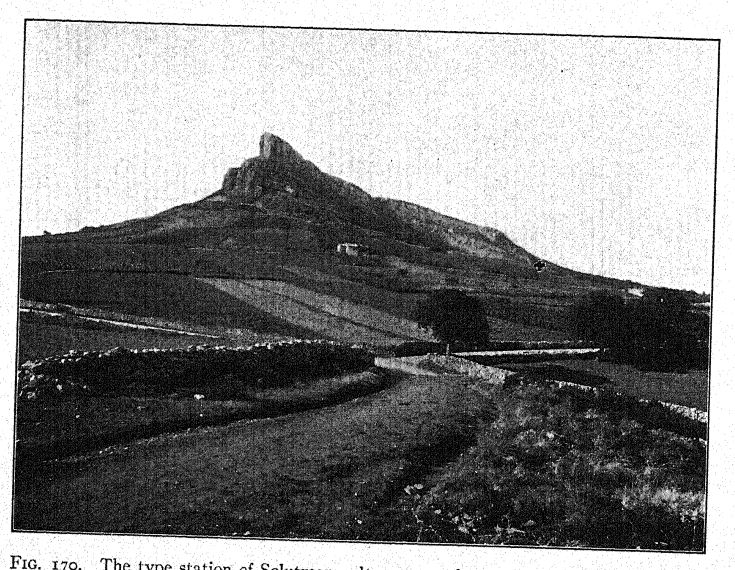
The type station of the Solutrean culture is the great openair camp of Solutre, near the Sadne, sheltered on the north by a seep ridge and with a fine sunny exposure toward the south. The traces of this great camp, which is the largest thus far discovered in western Europe, cover an area 300 feet square and are situated within a short distance of a good spring of water. As explored, in 1866, by Arcelin,55 Ferry, and Ducrost, this station had already been occupied in Aurignacian times; and two [ p. 343 ] sections, taken at two different points, showed the deposits of the old camp to be from 22 to 26 feet in thickness, representing superposed Aurignacian and Solutrean fire-hearths with thick layers of intermediate debris. In the Aurignacian level is found the vast accumulation of the bones of horses already described.
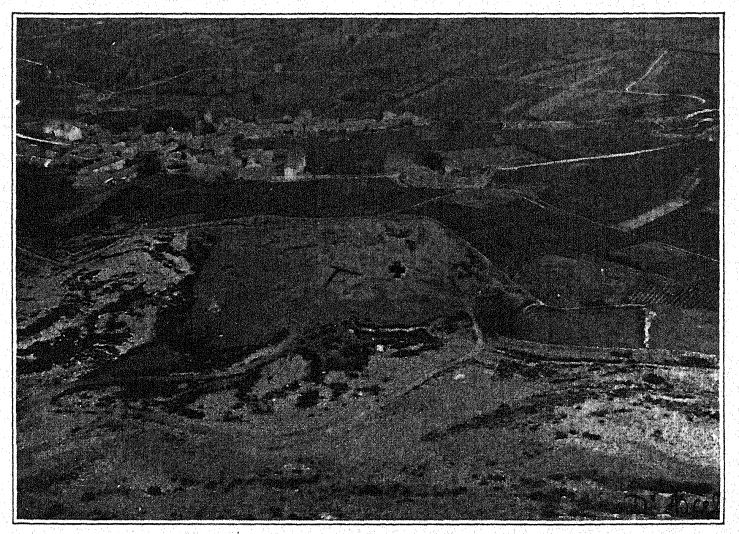
In the middle Solutrean levels great fireplaces are found with flint utensils and the remains of abundant feasts among the charred debris. The faima includes the wolf, the fox, the hyaena, both the cave and the brown bear, the badger, the rabbit, the stag, wild cattle, and two characteristic northern forms — the woolly mammoth and the reindeer ; the remains of the last are the most abundant in the ancient hearths.
In all the Solutrean stations, beside the bone implements,55 we find two distinct classes of flints. The first belongs to the entire ‘Reindeer Epoch’ and consists of single and double [ p. 344 ] scrapers, drills, burins, retouched flakes, and plain ones of small dimensions.
The second is composed of the ‘leaf’ types, which are solely characteristic of the Solutrean and which degenerate and entirely disappear at its close ; these latter are the arrow and lance head forms, many of which are fashioned with a rare degree of perfection and exhibit the beautiful broad Solutrean retouch across the entire surface of both sides of the flake, together with perfect symmetry, both lateral and bilateral; they are commonly knowm as the willow-leaf (narrow) and the laurel-leaf (broad) forms. The explorers of the type station of Solutré have discovered five principal shapes, as follows: (i) irregular lozenge; (2) oval, pointed at both ends; (3) oval, pointed at one end; (4) regular lozenge ; (5) arrow-head form with peduncle, doubtless for attachment to a shaft. The perfected Solutrean laurelleaf spear heads do not reappear in any other Upper Palaeolithic period, but their resemblance to Neolithic flints is very marked.
The ‘willow-leaf’ spear heads (pointes de saule), chipped on only one side, characteristic of the early Solutrean, may possibly be contemporary with the closing Aurignacian culture of Font Robert. At Solutre layers have also been discovered rich in bone implements and in graving-tools, as well as small ‘laurel-leaf’ points worked on only one face. As regards the general tendencies of the early Solutrean culture in Dordogne, at the Grotte du Trilobite (Yonne), and in Ardeche, there is a marked decline in the work in bone and in the variety and workmanship of all the implements, excepting only that of the primitive flattened spear heads, made of flakes, retouched in Solutrean fashion, but on one side only. Typical deposits of early Solutrean culture are found at Trou Magrite, in Belgium, at Font Robert, Correze, and in the third level of the Grotte du Trilobite, Yonne ; in the second level we find flints with the nascent Solutrean retouch.
The distinctive implement of the ‘high’ or middle Solutrean is the large ‘laurel-leaf’ point, flaked and chipped on both sides and attaining a marvellous perfection in technique and symmetry. [ p. 345 ] The finest examples of these spear heads are the famous pointes de laurier, fourteen in number, discovered at Volgu, Saone-etLoire, in 1873 : they were found together in a sort of cache and, it would seem probable, were intended as a votive offering, for one at least was colored red, and all were too fragile and delicate to be of any use in the chase. They are of unusual size, the smallest measuring 9 inches, and the largest over 13 ½. In workmanship they are equalled only by the marvellous Neolithic specimens of Egypt and Scandinavia.
At Solutre and other stations implements of bone are also found, although by no means of such frequent occurrence as in the later divisions of the Solutrean. While the most easterly Solutrean stations of Hungary exhibit no bone implements, these are abundant at Predmost, in Moravia, where the culture altogether is of an advanced Aurignacian type, with the Solutrean retouch used in the shaping of its flint spear heads. The bone industry includes a number of awls and smoothers, as well as numerous ‘bâtons de commandement.’ On this level at Predmost a few works of art are found consisting of the representations of four animals sculptured on nodules of limestone, the subjects apparently being reindeer, and also of one single engraving on bone.
The chief invention of the late Solutrean is the ‘shouldered point’ (pointe à cran), a single notched and very slender dart. These notches are the first indication of the value of the barb in holding a weapon in the flesh. Here also is a stem for the attachment of the shaft of the dart. In earlier stages of the Solutrean one finds flints where the unsymmetrical base of the ‘point’ shows a small obtuse tongue or stem. The elongate peduncle at the base of such spear heads (pointes à soie) is developed into the pointe à cran, or shouldered point, made of long, fine flakes, with a short retouch on one or both sides, and found in the late Solutrean at the grotto of Lacave, at Placard, and at many of the stations in Dordogne. No example of the pointe à cran has ever been found at the type station of Solutre, but it is of frequent occurrence at the stations between the Loire and the [ p. 346 ] Cantabrian Pyrenees, being found at Altamira, at Laugerie Haute, at Monthaud (Indre), in Chalosse and Charente, while the great cave of Placard has yielded no less than 5,000 specimens, whole and broken.
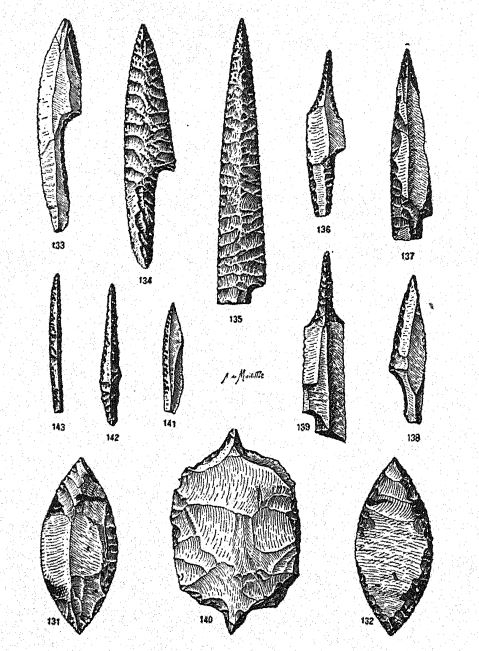
At Monthaud there are also found bone implements including a number of poinçons (awls) arid a series of sagaies (javelin points). Solutrean sagaies, however, are very rare and very primitive as compared with the Magdalenian.
[ p. 347 ]
The successive phases of Solutrean industry are all shown in southern France. As to its stratigraphic relations, the type station of Solutre exhibits lower and middle Solutrean above Aurignacian hearths and deposits; that of Placard, Charente, shows the middle and upper Solutrean overlaid by a Magdalenian layer. In the Grotte du Trilobite the Solutrean layer lies between one of Aurignacian and one of primitive Magdalenian ; it is here that we find the clearest transition from the Aurignacian culture in the appearance of prototypes of the laurel and willow-leaf points, made of flakes, retouched on only one side. At Brassempouy the Solutrean lies immediately beneath a Magdalenian layer, with engraved bones and Magdalenian flints. Needles, which are particularly abundant in the Magdalenian epoch, are also found in a number of the Solutrean stations. In the grotto of Lacave, Lot, in an upper Solutrean layer, Vire has found beautiful bone needles, pierced at one end and of fine workmanship, and engraved utensils of reindeer horn ; here also was found the head of an antelope engraved on a fragment of reindeer horn. The local fauna of this period included the horse, the ibex, and the reindeer.
¶ Solutrean Engraving and Animal Sculpture
The artistic work of Solutrean times is not so rich as that of the Aurignacian. This, as we have suggested, may be partly attributable to the less wide-spread distribution of the Solutrean culture, as well as to the great importance which was attached to the careful fashioning of the stone weapons. None the less we can trace indications of the development of both phases of art, the linear and the plastic, and especially the beginnings of animal sculpture. From the full, round sculpture of Aurignacian times there follows in Solutrean times a development of carving in bone of the Rundstabfiguren (bâton, or ceremonial staff), and of high relief. The lion®^ and the head of a horse at Isturitz, in the Pyrenees, which Breuil attributes to a late Solutrean period, are typical examples of this work.
[ p. 348 ]
Relatively rare are the parietal and mobile engravings as well as the schematic representations, such as are found at Placard and Champs Blancs. According to Alcalde del Rio, there are found at Altamira, in northern Spain, very simple, finely engraved figures of the doe on the bone of the shoulder-blade ; the head and neck are covered with lines, and both the eye and the nostril as well as the form of the ear are very characteristic of the animal. BreuLl, however, considers these as belonging rather to earlier Magdalenian times.
Decorative art certainly makes some advances over the Aurignacian work, because the arrangement of the geometric figures is quite clear, and the execution shows marked progress in the technique of engraving.
At Predmost, near the site of the human burial described above, there has been discovered a statuette of the mammoth sculptured in the round, in ivory, which proves that animal sculpture was well advanced in Solutrean times. The statuette was found six to nine feet beneath the surface of the ‘loess,’ in an undoubted Solutrean layer. The accompanying fauna is of a truly arctic character: the mammoth being extraordinarily abundant; the tundra forms including the mammoth, woolly rhinoceros, musk-ox, reindeer, arctic fox, arctic hare, glutton, and banded lemming; the Asiatic forms including the lion and leopard; the forest and meadow fauna embracing the wolf, fox, beaver, brown bear, bison, and wdld cattle, moose, and horse, also the ibex. Among the remnants of 30,000 flints there are a dozen points (feuilles de laurier) and other pieces with the Solutrean ‘retouch.'’ The industry in ivory, bone, and reindeer horn is also varied, including numerous poniards, polishers, piercers, dart-throwers, and bâtons de commandement.
This ivory sculpture of the mammoth indicates very accurately the characteristic contours of the top of the head, and of the back ; the striations on the side represent the falling masses of hair. Other sculptured figures representing the mammoth are believed to be of Magdalenian age, the best known being the figures found in the grottos of Bruniquel and Laugerie Basse, [ p. 349 ] a fragment from Raymonden, Dordogne, and a bas-relief in the grotto of Figuier, Card. All these sculptures of the mammoth have in common the indication of a very small ear —similar to that in the Predmost model— feet shaped like inverted mushrooms, bordered with short, coarse hairs, the tail terminating in a long tuft of hairs. If the figure of Predmost is of Solutrean age, it is by far the earliest of all the sculptured or engraved animal representations in the mobile art, and is also the most complete of the animal figurines of this group. It is certainly of more recent date than the engraved designs of Aurignacian age in the grottos of Gargas and of Chabot or than the red or black tracings of the mammoth, also of Aurignacian age, at Castillo, Pindal, and Font-de-Gaume. It is probable that the mammoth figures of Combarelles are of later date than the Predmost sculpture and belong to the beginning of Magdalenian times, while those at Font-de-Gaume belong to the end of Magdalenian [ p. 350 ] times and are the most recent of all the parietal designs. Despite the differences in age and technique, all the designs of the mammoth are undoubtedly the work of artists of a single race ; they agree in faithfully portraying the external form of this great proboscidian which wandered over the steppes and prairies of western Europe from the beginning of the fourth glaciation until near the close of Postglacial times.
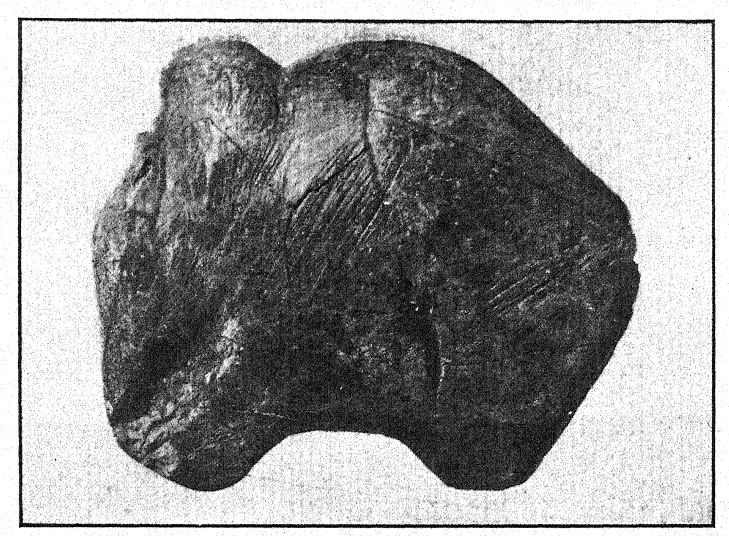
¶ Bibliography
(1) Breuil, 1912. 7.
(2) Verneau, 1906.1, pp. 202-207.
(3) Op. cit., p. 204.
(4) Keith, 1911.1, p. 60.
(5) Obermaier, 1912.1, p. 178.
(6) Breuil, 1912.7, p. 174.
(7) op. cit., pp. 165-168.
(8) Obermaier, 1 91 2.1, pp. 177, 178.
(9) Wiegers, 1913.1.
(10) Schmidt, 1912.1, p. 266.
(11) Geikie, 1914.1, p. 278.
(12) Dawkins, 1880.1, pp. 148, 149.
(13) Ewart, 1904.1.
(14) Obermaier, 1909.2, p. 145.
(15) Solias, 1913.1, p. 325.
(16) Broca, 1868.1.
(17) Lartet, 1875.1.
(18) Verneau, 1886.1; 1906.1, pp. 68, 69.
(19) Obermaier, 1912.2.
(20) Martin, R., 1914.1, pp. 15, 16.
(21) Keith, 1911.1, p. 71.
(22) Klaatsch, 1909.1.
(23) Keith, op. cit, p. 56.
(24) Hauser, 1909.1.
(25) Fischer, 1913.1.
(26) Schliz, 1912.1, p. 554.
(27) Breuil, 1912.7, p. 175.
(28) Op. cit., p. 183.
(29) Op. cit., pp. 177-180.
(30) Schmidt, 1912.1, p. 266.
(31) Breuil, op, cit, p. 178.
(32) Obermaier, 1912.1, p. 181.
(33) Breuil, 1912.7, p. 169.
(34) Breuil, 1912.1, pp. 194-200.
(35) Schmidt, 1912.1.
(36) Breuil, op. cit.
(37) Schmidt, 1912.1, p. 142.
(38) Breuil, 1912.1, p. 202.
(39) Breuil, 1912,6.
(40) Hilzheimer, 1913.1, p. 151.
(41) Fischer, 1913.1.
(42) Makowsky, 1902.1.
(43) Schwalbe, 1906.1.
(44) Makowsky, op. cit.
(45) Obermaier, 1912.1, pp. 342-355.
(46) Martin, R., 1914-1, pp. iS, 16.
(47) Schliz, 1912.1.
(48) Dechelette, 1908.1, voL I, p. 28.
(49) Keane, 1901. i, p. 147.
(50) Keith, 1911.X, p. 30.
(51) Op. cit., pp. 28-45.
(52) Op. cit., pp. 51-56,
(53) Obermaier, 1912. i, p. 93.
(54) Breuil, 1912.7, p. 188.
(55) Arcelin, 1869.1,
(56) Dechelette, 1908.1, voL I, pp. 137-141
(57) Schmidt, 1912. i, p. 144, Tafel B.
¶ Footnotes
See Appendix, Note VL. ↩︎
Named in honor of the reigning Prinee of Monaco, whose generous gifts and personal interest made the adequate exploration of these grottos possible. ↩︎
This correlation agrees in the main with that of Schmidt in his Diluviale Vorzeit Deutschlands. ↩︎
Denotes very frequent occurrence of a typical form. ↩︎ ↩︎ ↩︎ ↩︎ ↩︎
Denotes very frequent occurrence of a typical form. ↩︎
Breuil,34 Schmidt.35 ↩︎
The writer had the privilege of visiting all these caverns in the company either of Professor Emile Cartailhac, or of the Abbé Breuil. ↩︎
Despite Schwalbe’s statement, the supraorbital ridges in this skull appear to form a complete bridge. Doctor Hrdlicka regards the related Predmost skull as distinctly showing Neanderthaloid affinity. ↩︎